After we’d washed 9 days of Gobi desert from our hair and clothes, we embarked upon an 8 day trip to the lesser-travelled eastern area of Mongolia, famous as the birthplace of Temujin, the boy who would grow up to become the great Chinggis Khaan.
Planning
As we’d enjoyed our Gobi trip with the Golden Gobi hostel so much, we asked them to arrange an eastern trip for us as it’s not an area they usually do tours to. Boss Oogii said she would make up an itinerary for us but having asked almost two weeks prior, none was forthcoming. With 3 days left before we wanted to depart, we got sick of being fobbed off and took the hint that they didn’t want our money. I guess during peak season the Golden Gobi are only interested in their very good pre-planned tours.
Our excellent Chinggis guesthouse also does tours (as do most guesthouses and hostels in Ulaanbaatar), and we only needed to mention we were interested in a tour once and it was almost a foregone conclusion that we’d booked!
With the Lonely Planet as a starting point and our £3 tourist map of Mongolia from the State Department Store, we sat down with guesthouse owner Saikhnaa, her son Yesukhei and their 3 maps to plan a suitable route taking in other interesting sights they know about along the way. After a little haggle on the price of a guide, which Saikhnaa was adamant we would need given the harsh roads we would encounter near Dadal, and we were adamant we wouldn’t need and just added to the cost, we agreed that Yesukhei would join us on our road trip.
As we were now at the night before, we needed to meet our driver and get our provisions bought at the local supermarket.
Day 1 – Gorkhi-Terelj National Park, Lama hiding rock, Turtle Rock, White Elephant Monastery
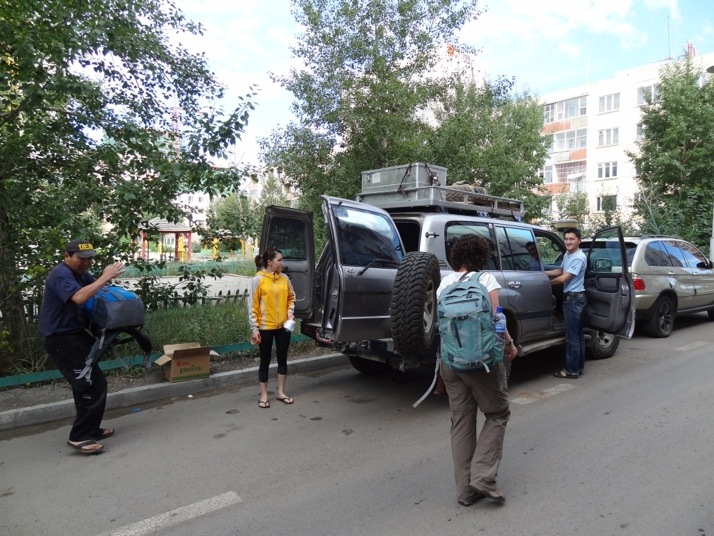 Packing the Land Cruiser for adventure! Left to Right: Bacha our driver, Temuulen (Saikhnaa’s daughter and Yesukhei’s little sister who almost single-handedly runs the guest house), Julie and Yesukhei
Packing the Land Cruiser for adventure! Left to Right: Bacha our driver, Temuulen (Saikhnaa’s daughter and Yesukhei’s little sister who almost single-handedly runs the guest house), Julie and Yesukhei
We set off about 9:30, then quickly returned to the guesthouse as we’d forgotten to pack the table and chairs from Saikhnaa’s car. We may be headed to the wilds of Mongolia, but dammit, we had to be civilised.
The traffic and bustle of UB soon gave way to a poorly maintained single-carriageway concrete road headed east. As we’d found out on our trip to Kharkhorin, every road seems to be in a state of repair, which means diversions onto grassland either side. The further away from UB we travelled, the better the road got until we stopped to fill the tank, then shortly afterwards took a left towards Terelj, stopping at the national park border.
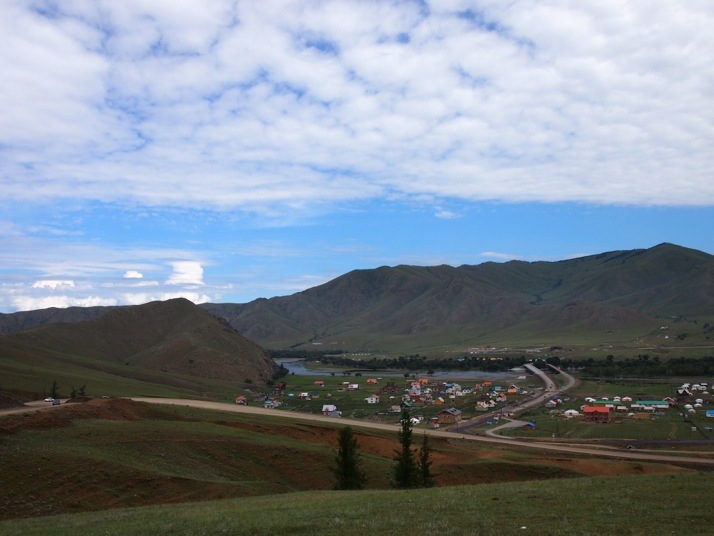 Entrance to Gorkhi-Terelj National Park, a popular weekend destination for tourists and Ulaanbaatarites alike
Entrance to Gorkhi-Terelj National Park, a popular weekend destination for tourists and Ulaanbaatarites alike
Our first stop in the park was a rock formation that Yesukhei told us was used as a hiding place for 100 Lamas during the Stalinist-era religious purges. We climbed into the rock and while it was big inside, it would have been a squeeze for 100!
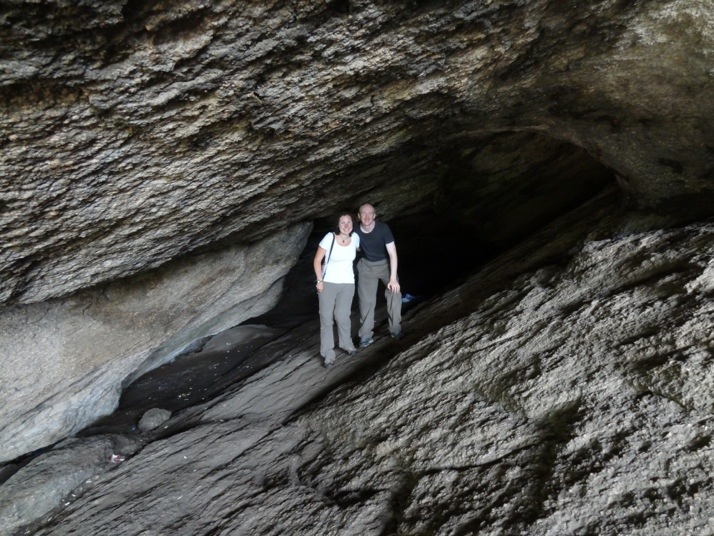 Us inside the Lama hideout, hiding out
Us inside the Lama hideout, hiding out
A little further up the road is the most famous landmark in Terelj, the aptly named Turtle Rock. Again, Yesukhei led the way like he’d grown up holidaying on these rocks, and in simple flip-flops he put us to shame in our proper hiking shoes!
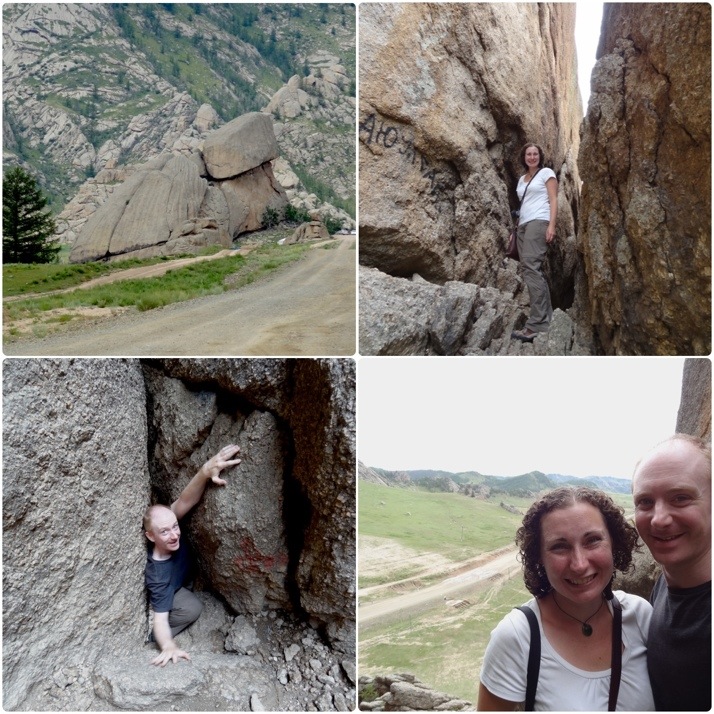 Climbing the Turtle
Climbing the Turtle
The last stop before we started looking for a campsite was the Aryapala Initiation and Meditation Centre, with the recently constructed White Elephant Monastery. Sadly the death-slide / zip-line was closed, but it does have a sort of Buddhist “wheel-of-fortune” which is a prayer-wheel that points you to a sentence to contemplate, which you will find on billboards as you walk towards the Monastery.
Here’s Julie’s, #68:
If the mind is found to be dull due to sleepiness and mental torpor or if you fear that dullness is approaching, then the mind should attend to a supremely delightful object such as an image of the Buddha, or a notion of light. In this process, having dispelled dullness the mind should try to see the object very clearly.
And Andrew’s, #21:
Whether you are engaged in one-pointed meditation or pursuing your ordinary activities, meditate on compassion at all times, focusing on all sentient beings and wishing that they all be free from suffering. Begin by meditating on your friends and relatives. Recognise how they experience the various sufferings that have been explained.
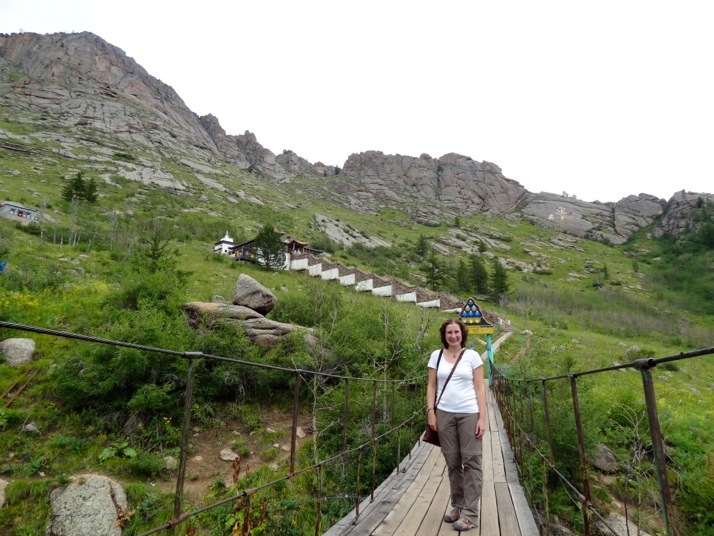 The walk to Monastery includes a little rope-bridge
The walk to Monastery includes a little rope-bridge
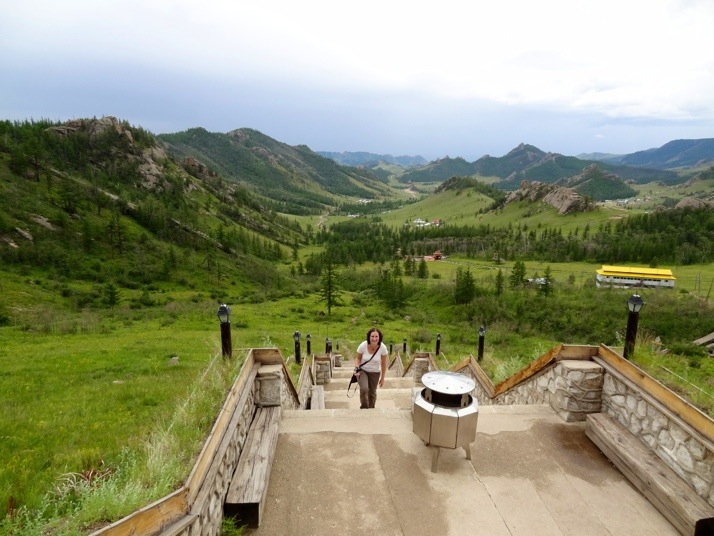 After a long walk uphill, we were rewarded with a long staircase that was built to resemble the trunk of a White Elephant
After a long walk uphill, we were rewarded with a long staircase that was built to resemble the trunk of a White Elephant
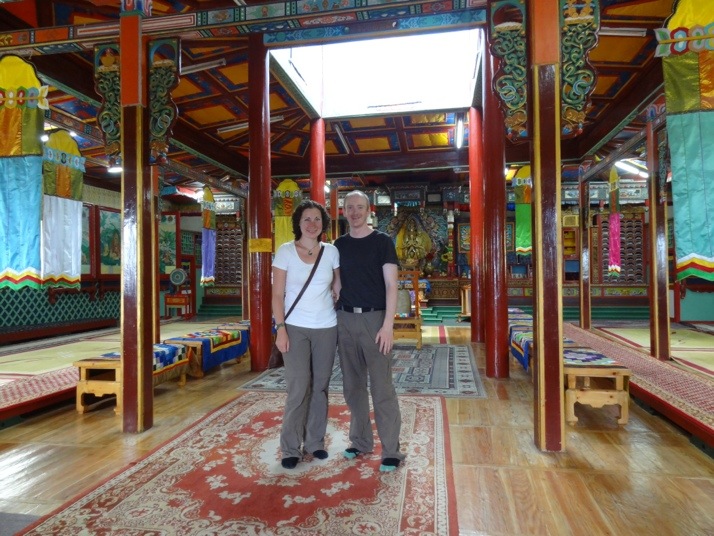 The Monastery is light and brightly painted inside
The Monastery is light and brightly painted inside
As it was getting on for 3pm, we headed further into the park and away from the many tourist ger camps to find a suitable place to pitch our tents. Yesukhei tried to contact a family that was looking after his father’s horses, but they were the on the other side of the Terelj river, which, despite Bacha’s Land Cruiser being equipped with a snorkel, the recent wet weather meant the river was too fast and too swollen to cross. Instead we passed through the little town of Terelj, which has a five-star hotel and golf course in it (!), and found a lovely spot in an open field not far from the town and the river.
Exhausted from a morning of driving and guiding, our companions had a snooze while we decided to climb the nearest hill.
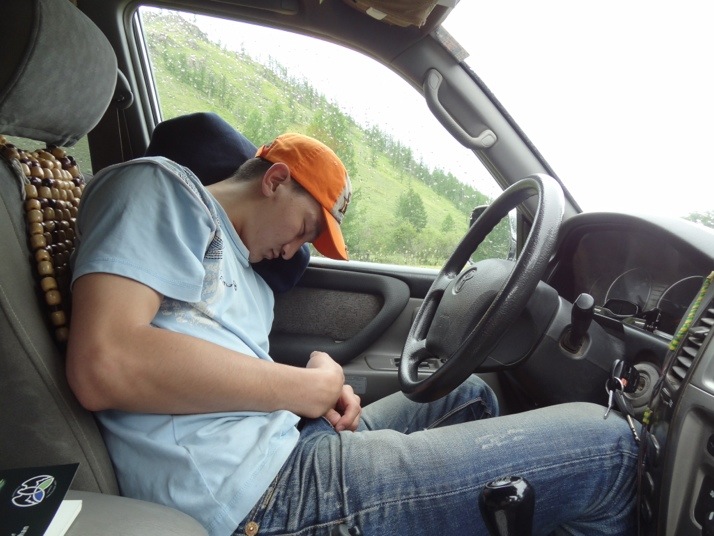 Yesukhei comatose after a morning’s guiding
Yesukhei comatose after a morning’s guiding
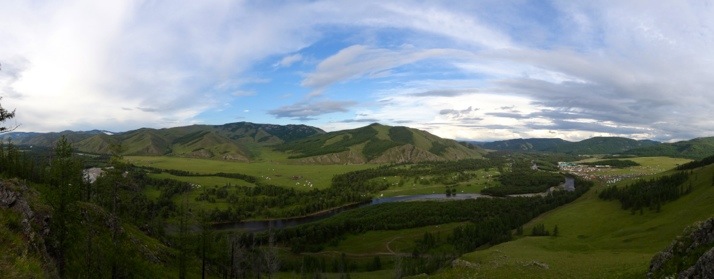 Stunning views of the valley from the top of the hill. Our campsite is the white dot at the bottom centre
Stunning views of the valley from the top of the hill. Our campsite is the white dot at the bottom centre
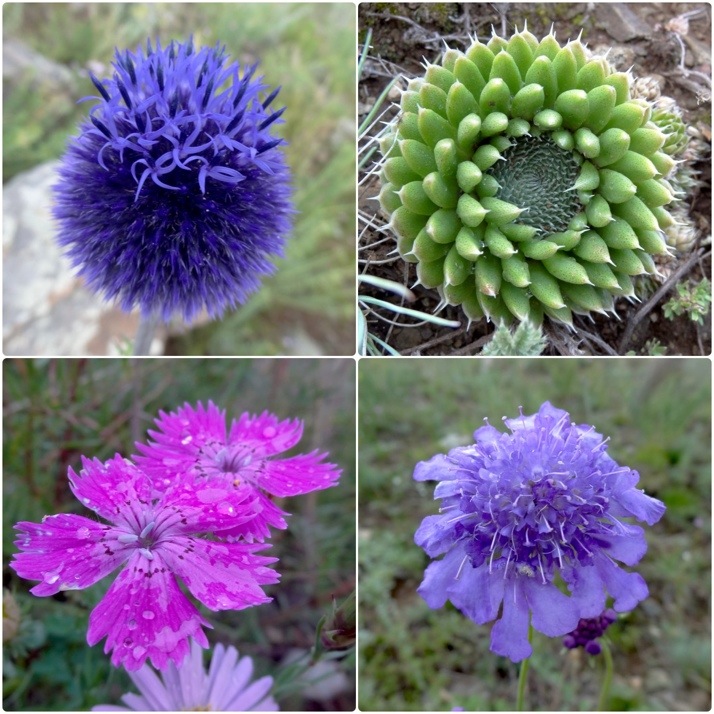 We stopped on the way up and the way down to photograph some of the interesting flora
We stopped on the way up and the way down to photograph some of the interesting flora
Yesukhei made a lovely dinner for us, and then pitched in to help with the dishes before we retired to our tents for the night.
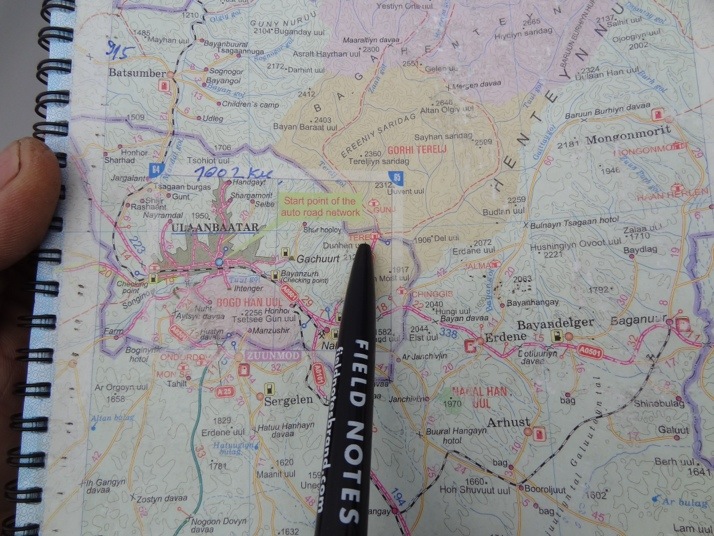 End of day 1, camping in Gorkhi-Terelj National Park
End of day 1, camping in Gorkhi-Terelj National Park
Day 2 – Hiking in Gorkhi-Terelj National Park, and the sacking of our guide
The next day we’d planned to go hiking in the park, and after a spot of breakfast and some light entertainment from Bacha as he imitated the call of a bull, Julie and I set off to explore the valley north of the park’s namesake town. Yesukhei suggested we take one of his phones in case we needed picking up, and we agreed we’d be back in the camp between 3 and 4pm.
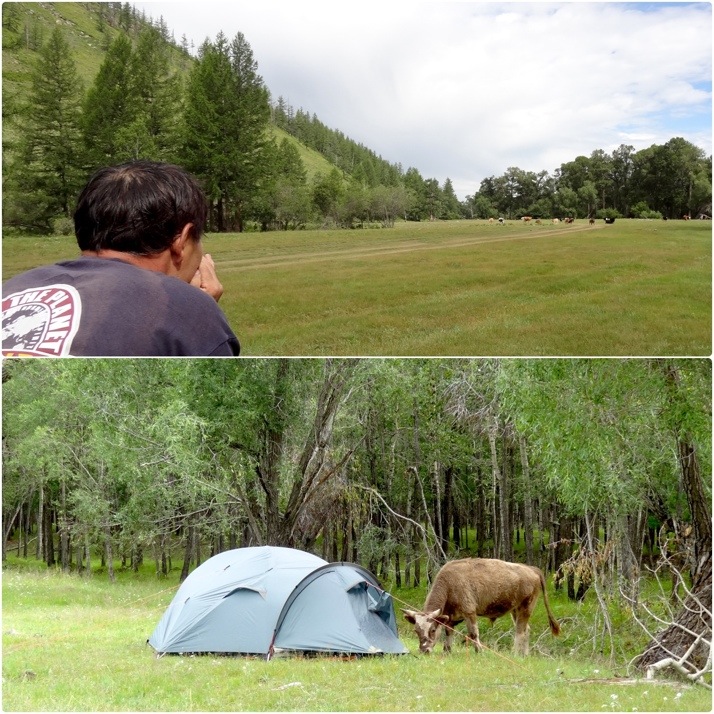 Bacha imitating the call of a powerful bull, quite successfully too as a cow starts sniffing around his tent
Bacha imitating the call of a powerful bull, quite successfully too as a cow starts sniffing around his tent
The walk up the valley was long and gentle at first, the locals’ gers giving way to smaller valleys either side and the odd tourist ger camp. Getting out of the town also helped dwindle the swarm of flies that decided to join us, but thankfully didn’t dissuade a local dog that fancied a walk too.
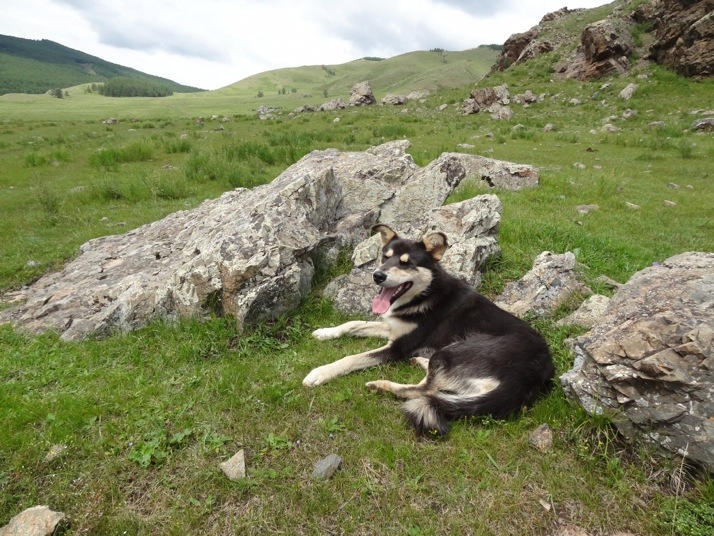 Our guide for the day. Julie named him Chinggis
Our guide for the day. Julie named him Chinggis
As we neared the end of the valley, we decided to climb up the ridge to the forest near the top to check out the view and see if it was possible to drop back down to the campsite, but as we neared the top we could hear roars of thunder until we saw that every other neighbouring valley was under rainfall. 15 minutes later the rain moved in on us and even with our raincoats on we got a good soaking as we headed off the hills and back towards the town.
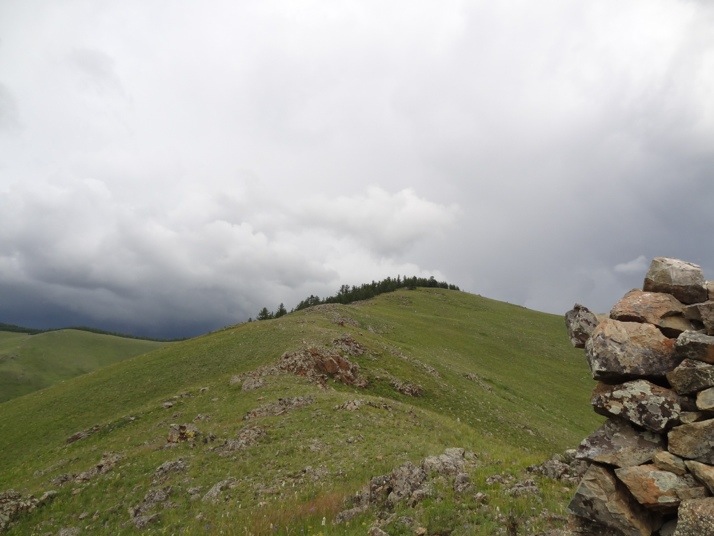 View of the top. Those dark clouds looking awfully close
View of the top. Those dark clouds looking awfully close
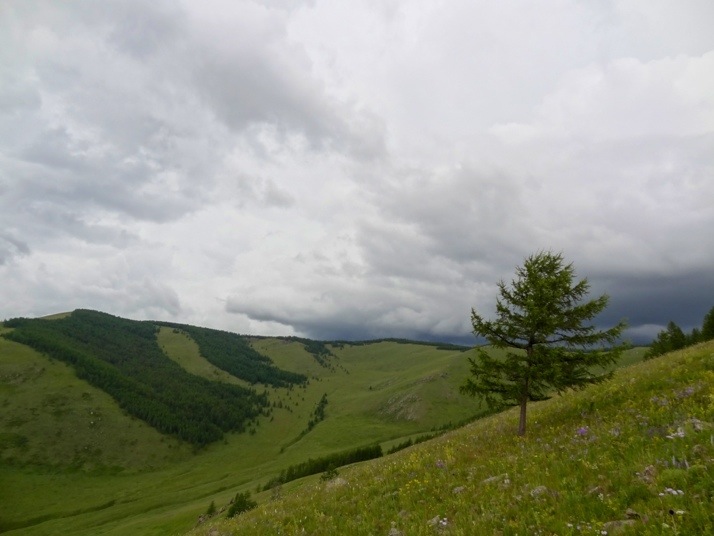 View from the top, before the rains came in
View from the top, before the rains came in
We were pretty much spot on with our timing as we approached the campsite just after 3pm, then we heard our jeep. Yesukhei was at the wheel and said he was worried about us and that he was coming out to find us. Initially we weren’t too happy about it, as it wasn’t what we’d agreed and, even though he would only have driven a few kilometres, we were paying for the diesel and all of our stuff was in the jeep – what if something had happened to him in the jeep? He’s not as experienced as Bacha.
When Yesukhei parked up we opened the back doors to get a few things from our bags and Julie spotted an almost empty 2.5 ltr bottle of beer in the footwell. First, Yesukhei denied drinking, then when I told him I could smell it on his breath he said he’d only had one or two, and that Bacha had been drinking and offered it to him. He then wanted to drive into town to buy us a surprise, yep, he wanted to get us some beer. At this point we asked for the car keys which he reluctantly handed over. Julie and I then talked over our options, and decided that it wouldn’t be much of a holiday for us if we had to babysit a 24-year old, so after checking with Bacha if he would be OK to continue the tour without Yesukhei, we made the decision to drop him off at the nearest bus stop in the morning, which was about an hour from UB.
We later found a second empty 2.5 ltr bottle bottle of beer in the camp’s rubbish bin.
While alcoholism is a big problem in Mongolia, and UB in particular, we don’t think Yesukhei is an alcoholic. We thought his behaviour was simply irresponsible. In our minds he was still at work at 3pm and “on call” in case we needed him in an emergency, and to take the jeep out to come and find us was, I thought, just an excuse to drive someone else’s off-road 4×4 on someone else’s diesel money.
I couldn’t help but think it was such a shame, Yesukhei had been so good the day before, and I thought we’d started to get to along really well. I also couldn’t help thinking that I hoped his Mum would give him a really hard time when he got home.
Day 3 – Chinggis Khaan Statue
After a short 15km detour to the town of Nalayh to drop Yesukhei off at the bus station, we continued east-ward on the main road out of UB until we reached one of the most famous monuments in Mongolia – the giant statue of Chinggis Khaan.
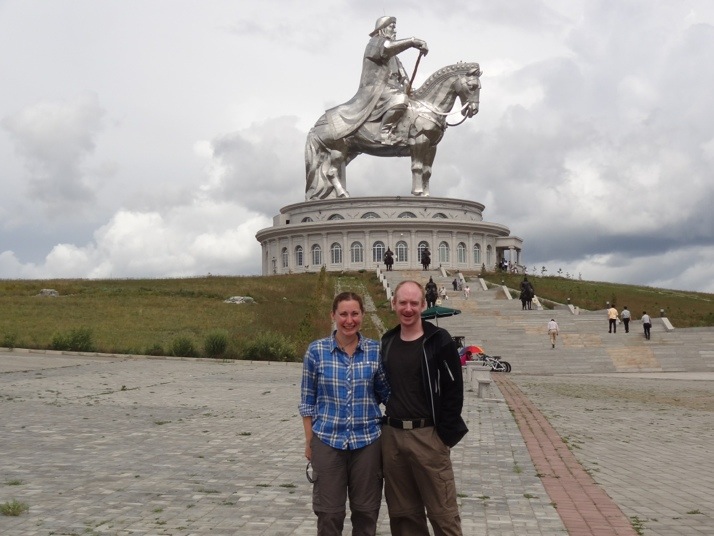 Us in front of the massive metal monument to Chinggis Khaan, a couple of hours east of UB
Us in front of the massive metal monument to Chinggis Khaan, a couple of hours east of UB
Inside is a museum which was being renovated, a couple of cafes and a souvenir shop, but the best bit, besides seeing a massive mounted shiny Chinggis is that there’s a lift inside which leads to..
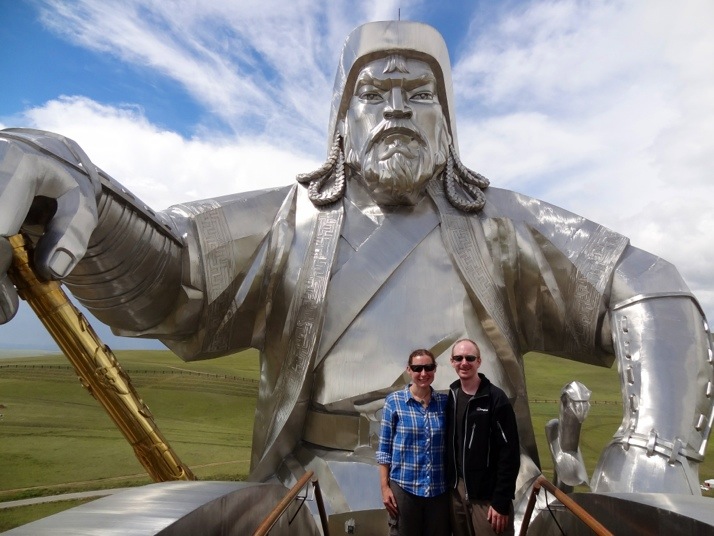 Us on Chinggis Khaan’s horse’s head!
Us on Chinggis Khaan’s horse’s head!
Then, after passing the largest opencast coal mine in Mongolia, we stopped on a hill for a quick spot of lunch.
There’s an infamous curry eating competition held in a Newcastle upon Tyne restaurant, whereby victims clientele have to clear a plate of the hottest curry the chef can produce. In an interview I read of this annual event, one participant described the effect of the curry to be like having a chainsaw covered in hot-sauce shoved into his stomach.
I was reminded of this vivid description of fiery pain as we tucked into our lunch of the Korean equivalent of a Pot Noodle. The only English words on the packaging were “spicy mushroom”, But honestly, they could just write “spicy” because after the first mouthful we couldn’t taste anything but our own molten taste buds.
Our mouths still reeling, we dropped into the valley and made our way seemingly off-road towards our destination for the night: Khökh Nuur, which means “blue lake”, and is where Temujin first proclaimed himself a Khaan. He had good taste..
[youtube=http://www.youtube.com/watch?v=UnPVstUBlnY]Crossing a deep river on our way to Khökh Nuur
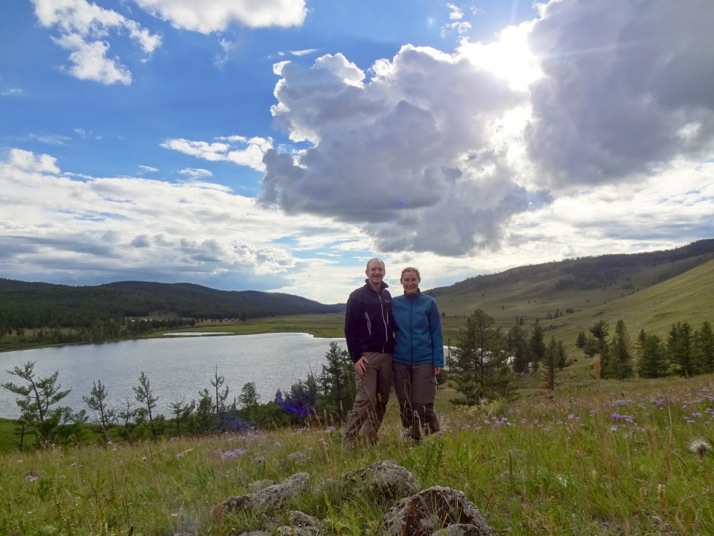 Us at Khökh Nuur, site of Temujin naming himself Chinggis Khaan
Us at Khökh Nuur, site of Temujin naming himself Chinggis Khaan
Our guide book says the local ranger demands a fee of 1000 MNT stating it’s a protected area, but it isn’t. The fee has gone up to 2,500 MNT for entry, and maybe because we paid it, he then produced another official looking receipt with “jeep” written on it that was also 2,500 MNT. To us, that’s ~£2.60 which we’d struggle to find a campsite for back home and we weren’t so concerned about the cost.
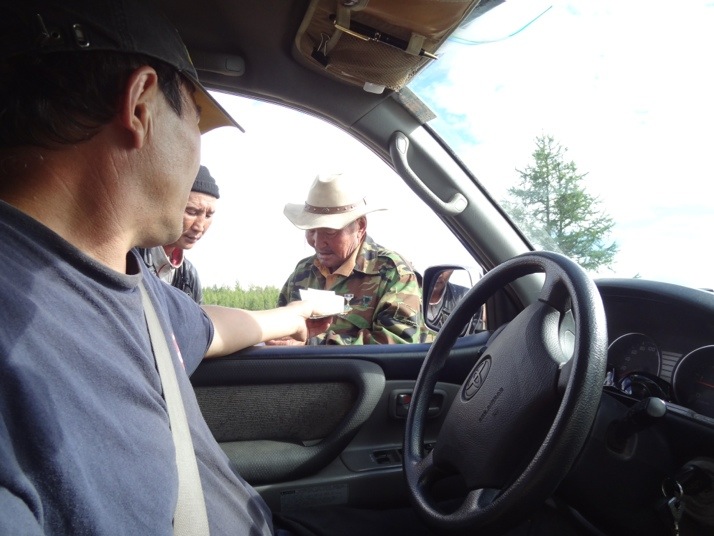 The Khökh Nuur extortion racket (according to our guidebook). Not sure I’d argue with their park “entrance” fee, as they do look somewhat official
The Khökh Nuur extortion racket (according to our guidebook). Not sure I’d argue with their park “entrance” fee, as they do look somewhat official
Julie and I were putting the kettle on, and basking in the tranquility of our lakeside camp surrounded by beautiful hills and reddening sunset, when 2 jeeps, 1 minivan and a small coach appeared and proceeded to set up camp less than a stones throw away. After 8 people got out of the minivan, they started unloading the luggage which included a live, hog-tied goat. It had survived the journey, but it didn’t survive much longer.
3 young guys from the group came over and introduced themselves as Traffic Policemen from UB, and we later found out two things; firstly, all holidays for all Police forces were suspended during the Nadaam festival and this was their last night of their first family holiday since the celebrations, and second, they loved to sing. 2 songs in strict rotation. Until 3am. You know the saying “if you can’t beat them, join them”? We were very close to beating them.
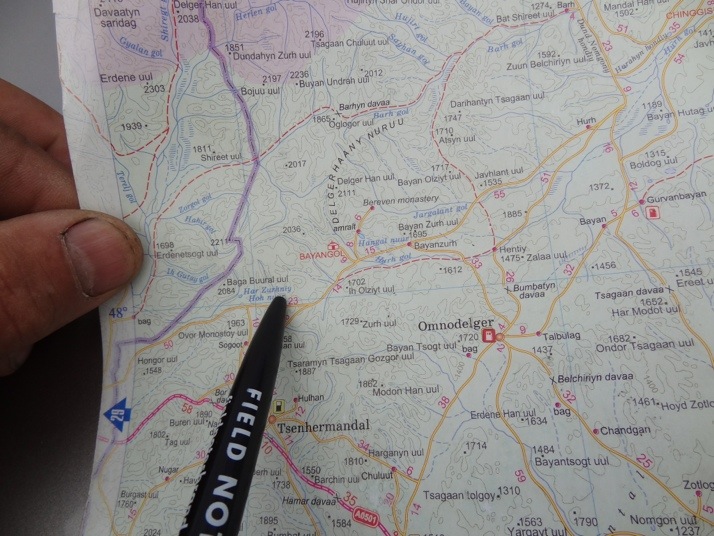 End of day 3, camping next to Khökh Nuur (blue lake)
End of day 3, camping next to Khökh Nuur (blue lake)
Day 4 – Baldan Bereeven Khiid Monastery & Öglögchiin Kherem (Almsgivers Wall)
Unsurprisingly, our karaoke party-lovers were still in bed when we packed up our camp, and hadn’t been stirred by the smell of Bacha’s fantastic breakfast.
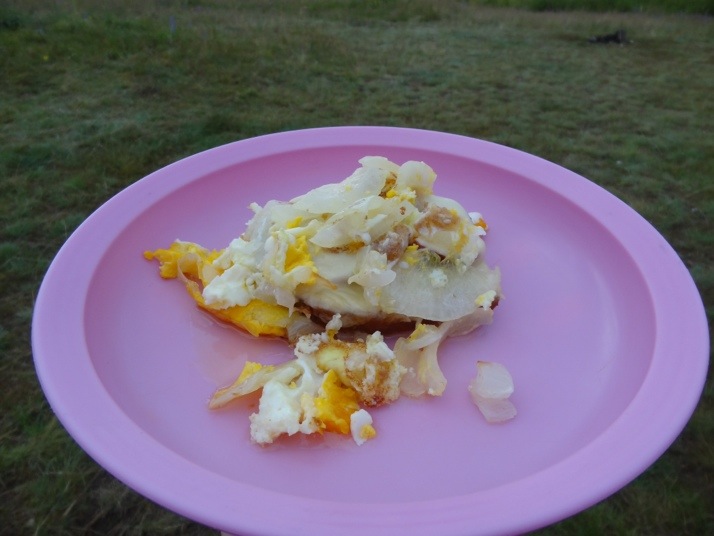 Bacha’s breakfast. Mmmm, tasty!
Bacha’s breakfast. Mmmm, tasty!
How to make Bacha’s breakfast (he doesn’t have a special name for it, he says he just made it up!)
- Fry some onions in a little oil, not too far, they should still be a little crunchy at the end
- Crack an egg onto the onions, one per person
- Place a slice of bread on each egg
- Throw in some chopped meat. Salami, sausage, you get the idea
- The final ingredient is a slice of cheese. We only had processed cheese slices, but grated cheese would probably taste better
- When the cheese starts to melt, serve. Plastic plate is optional.
On the drive out of the valley, Julie spotted a marmot. A marmot!
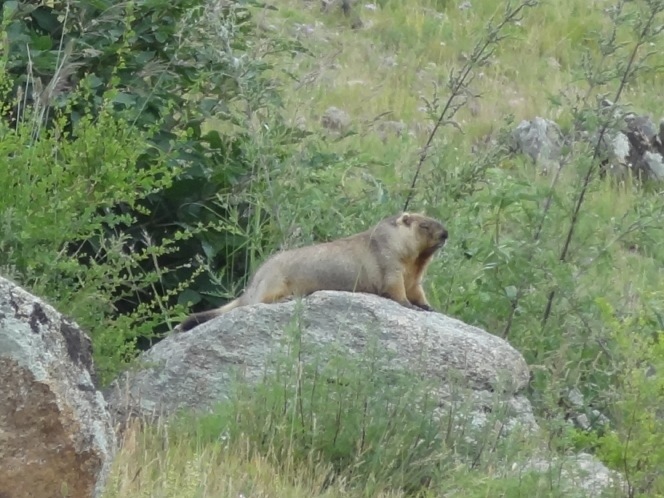 MARMOT!
MARMOT!
By now, Mongolia is starting to feel like a very large version of our home in the north of England – rolling green hills, cloudy skies, frequent rain..
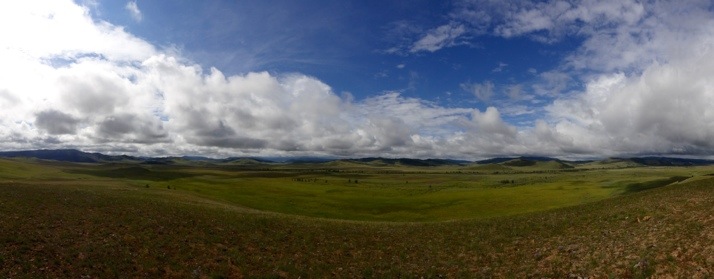 Stunningly vast and empty Mongolian scenery
Stunningly vast and empty Mongolian scenery
Our guidebook says of our next destination, Baldan Bereeven Khiid:
This monastery (GPS: N48° 11.910’, E109° 25.840’; admission T2000) in Ömnödelger sum was first built in 1700. At its peak it was one of the three largest monasteries in Mongolia and home to 5000 lamas. Communist thugs destroyed it in the 1930s. Now only ruins remain, but impressive ruins they are.
Well, the Mongolian Lamas have been busy again, as the beautiful main temple has been rebuilt, along with a smaller temple in a somewhat sorry state off to the left.
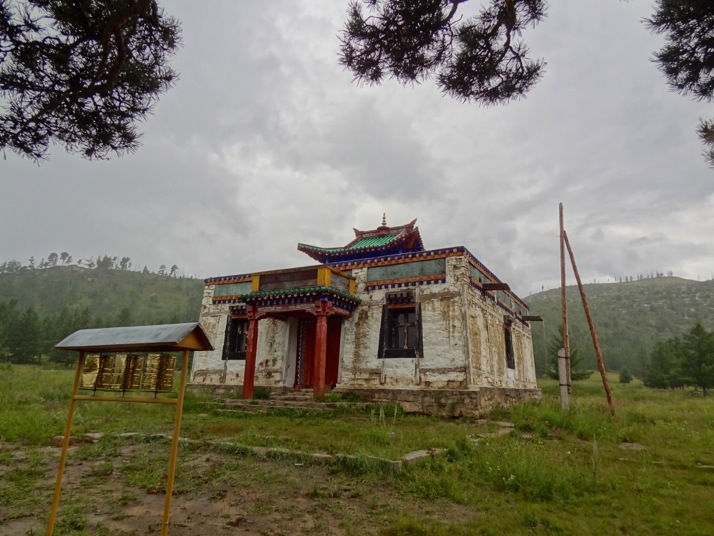 The smaller temple to the left, just as the rain starts again
The smaller temple to the left, just as the rain starts again
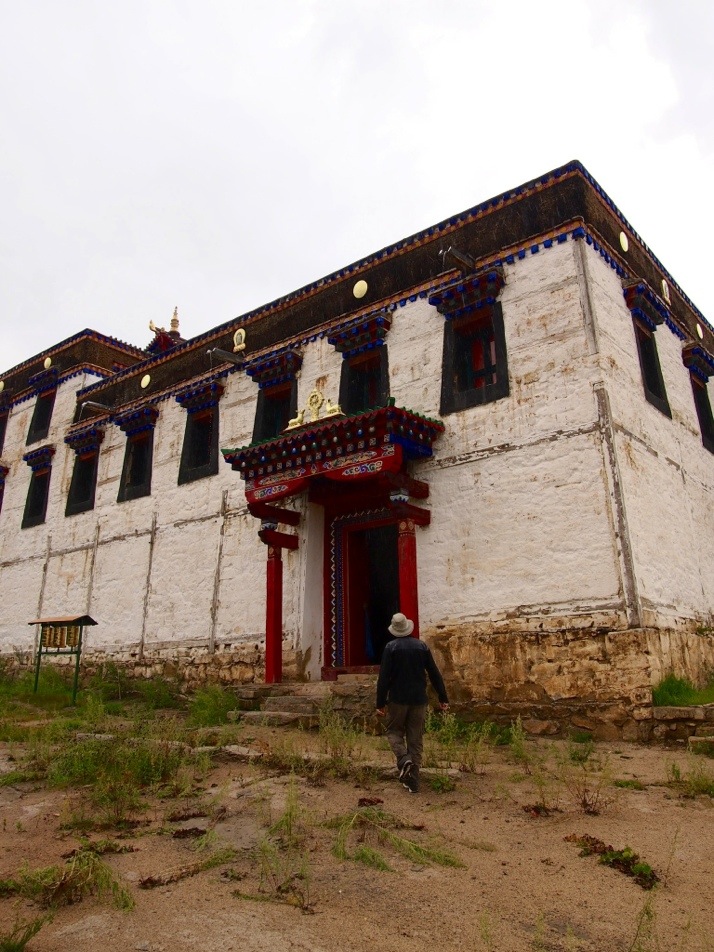 Me walking into the side entrance of the re-built main temple, seeking solace from the weather
Me walking into the side entrance of the re-built main temple, seeking solace from the weather
Because it was chucking it down, we curtailed our visit – instead of taking the recommended clockwise loop of sights and attractions, we picked out the obvious closer ones to the right of the monastery.
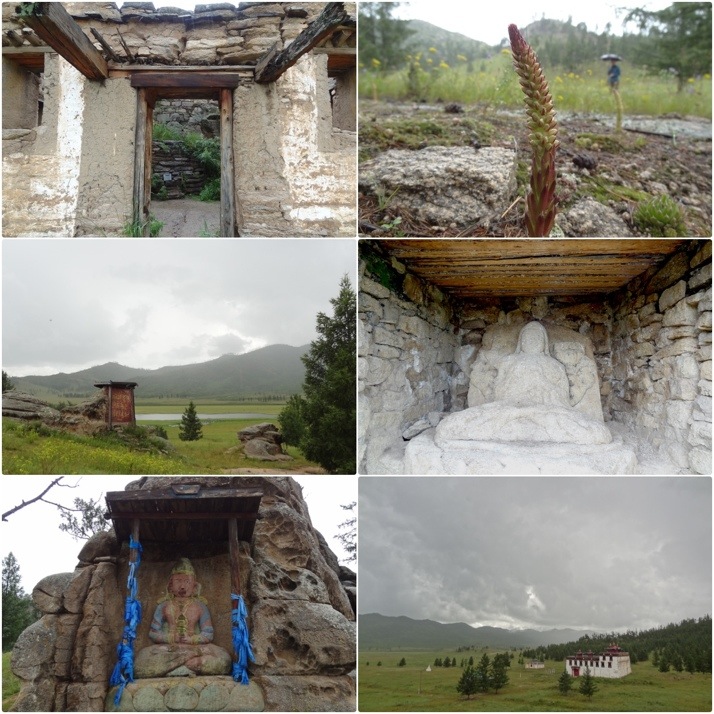 Clockwise, from top-left: Remains of an old temple that still contains a tiny Buddha statue; Interesting flora behind the main temple; Large Buddha statue; View of the Monastery from the hillside in the rain; A colourful Buddha near the grounds entrance; A painted rock-face sign and view of the lake opposite of the Monastery
Clockwise, from top-left: Remains of an old temple that still contains a tiny Buddha statue; Interesting flora behind the main temple; Large Buddha statue; View of the Monastery from the hillside in the rain; A colourful Buddha near the grounds entrance; A painted rock-face sign and view of the lake opposite of the Monastery
En-route to our next destination, and not really surprising given the days of rainfall we’d experienced, we stopped to assist a family with a minivan that had gotten themselves stuck. Not a problem for Bacha’s low-ratio, 4-wheel drive engaged, black-smoke belching Land Cruiser – in less time than it took all 10 people to get out, we’d pulled their little people carrier free.
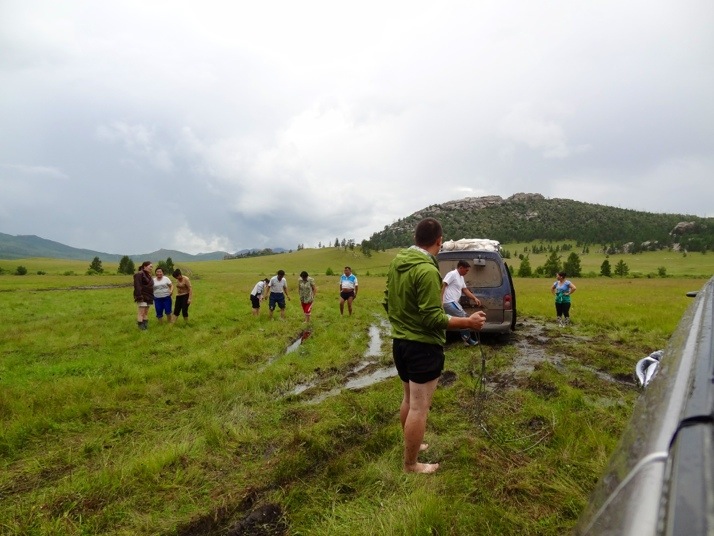 10 people, with luggage? No wonder they got stuck!
10 people, with luggage? No wonder they got stuck!
The road (hah!) was pretty bad, and as it rolled on for 3pm with little sign of the rain abating, Bacha suggested we stop at a nearby group of houses which might be able to cook us up some lunch. We waited outside while Bacha went in to investigate, and 5 minutes later he emerged with news of mutton stew – fantastic!
As Julie has already written about, what followed was a Buryat feast cooked in front of us in an old Russian era farmhouse, while we drank as much salty tea as we dared. Every 5 minutes groups of locals would arrive, have a quick cuppa and a natter with our husband and wife chef team and then continue on their way to their Naadam festival which was scheduled for the following day.
Sadly we don’t have any pictures of the meal, but I’ll have a go at describing it in less than a thousand words.. picture this: we were each handed an oval plastic plate containing a boiled potato, a boiled carrot, 2 bones with meat and fat enough to make a St Bernard smile, topped off with a boiled cabbage leaf the size of the plate. And the accoutrements with which to tackle such hearty fayre? How about a 6″ hunters knife from the set of Crocodile Dundee?
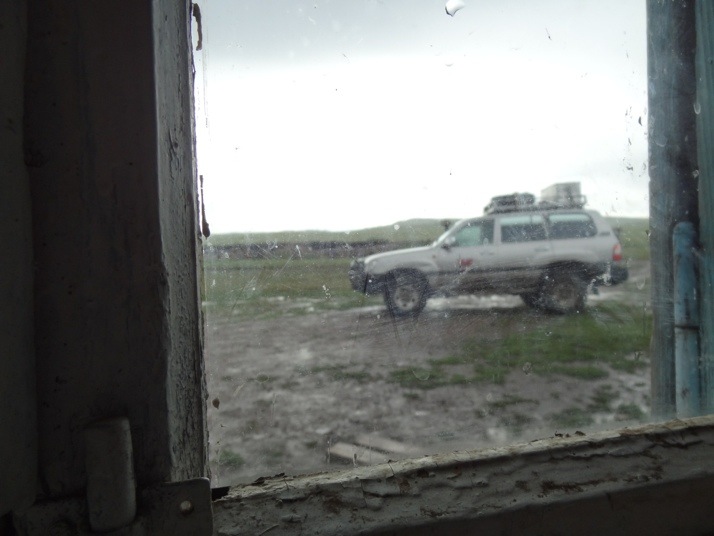 Our van from the kitchen window
Our van from the kitchen window
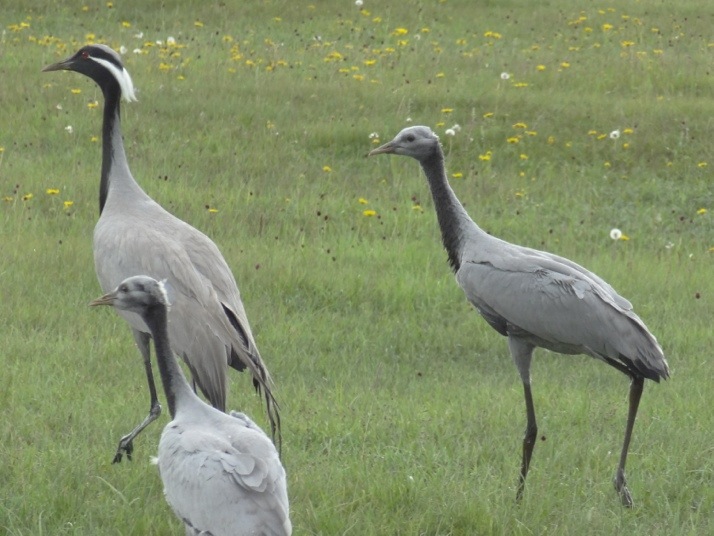 A family of Cranes, spotted on our way to Öglögchiin Kherem
A family of Cranes, spotted on our way to Öglögchiin Kherem
Again, to quote our guidebook:
Öglögchiin Kherem – Literally ‘Almsgivers Wall’, but also known as ‘Chinggis Khaan’s Castle’ or ‘Red Rock’, this 3.2km-long stone wall (GPS: N48° 24.443’, E110° 11.812’), believed to date from the 8th century, stretches around a rocky slope in Batshireet sum. It was once thought to be a defensive work or a game preserve, but recent archaeological digs by a Mongolian-American research team have identified at least 60 ancient graves within the walls, indicating that it may have been a royal cemetery. As you walk inside the grounds you may see small red signs, marking the location of graves excavated in 2002.
Mercifully, the sun was shining as we rounded the hillside into an enclosed pasture, the Wall looming over us up ahead. Bacha dropped us off at the exact GPS location, and left us to hike up the rocks and hillside toward the wall itself.
However, the trekking was hard going in the tall, wet grasses, and the mosquitos were relentless. Having climbed half-way up the hillside, and with no discernible path ahead we decided to turn back, and before meeting up with Bacha, I felt compelled to climb the pile of rocks near the entrance.
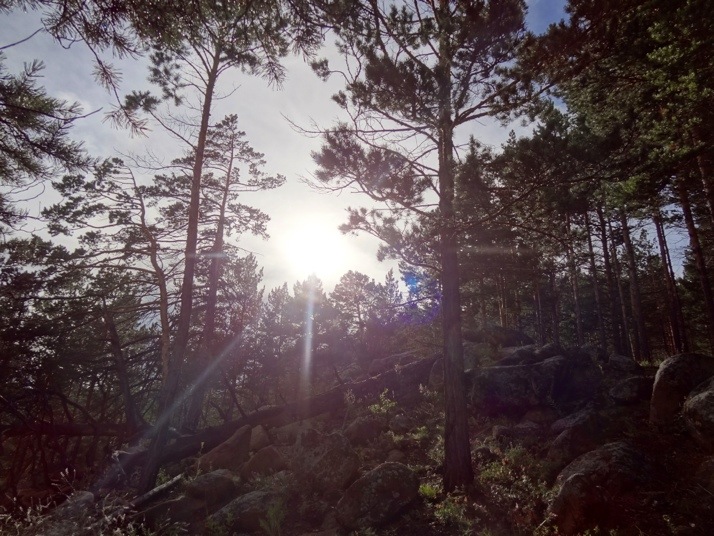 The view up the hillside from where we turned back
The view up the hillside from where we turned back
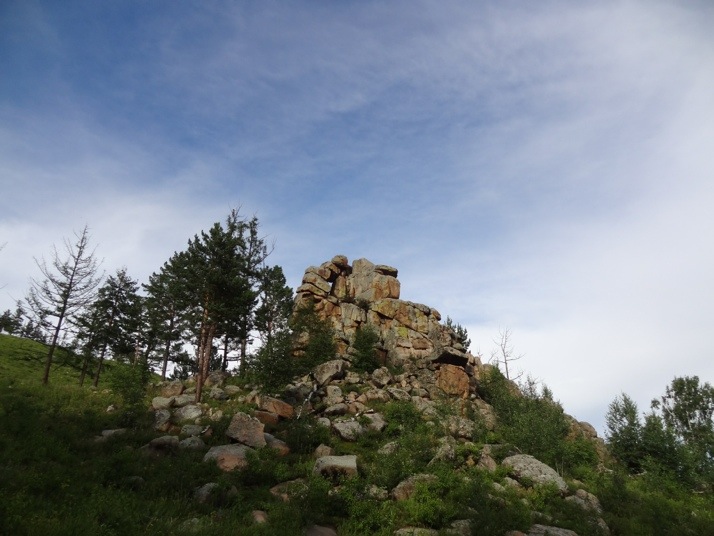 The challenge!
The challenge!
The climb was pretty straightforward, but as we neared the top the rocks were in the shade and were still slippery from the recent rainfall. As I made my attempt on the last rock my footing slipped out from under me and for a split second I thought I was going to fall further than my last push, land on some uneven surface, and either twist or break something. Fortunately my footing recovered and a little shaken I made a second, successful attempt.
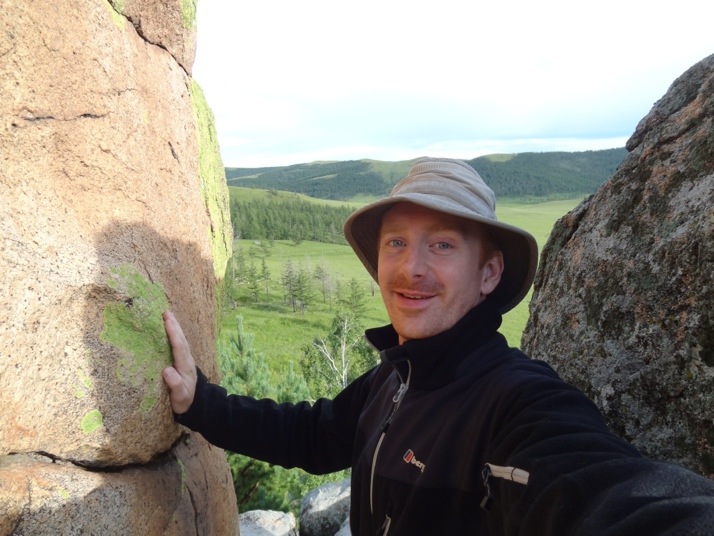 At the top! (well, as far as I could go without climbing gear or a ladder!)
At the top! (well, as far as I could go without climbing gear or a ladder!)
On the way down, which we both took very carefully, Julie thought she saw a snake.. and she had!!
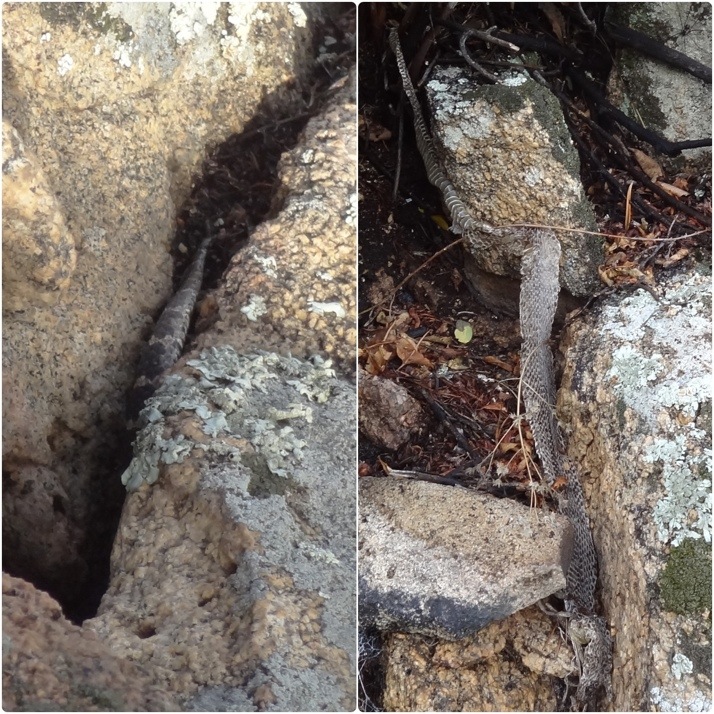 Left: a snake disappearing into the rocks we were climbing down; Right: Likely it’s former winter coat
Left: a snake disappearing into the rocks we were climbing down; Right: Likely it’s former winter coat
We gingerly made our way back to the jeep, watching every step, and relieved to be back in the safety and comfort of the jeep, we continued on towards the town of Binder and our camp for the night.
After stopping to fill up on the outskirts of Binder, and enquiring about the pass-ability of the Hurh river, we headed out towards it to look for a suitable camping spot, stopping at an interesting looking monument on the way as the sun started to set..
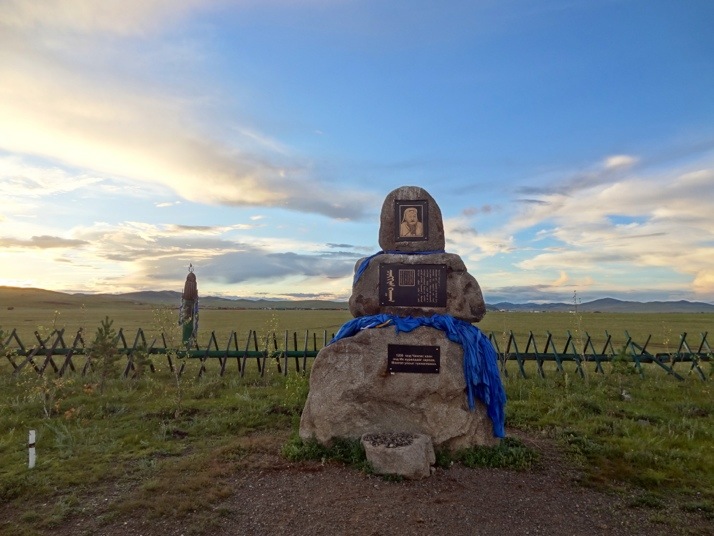 The inscription explains that this was the site where Chinggis Khaan united the heads of the Mongol tribes into a single nation
The inscription explains that this was the site where Chinggis Khaan united the heads of the Mongol tribes into a single nation
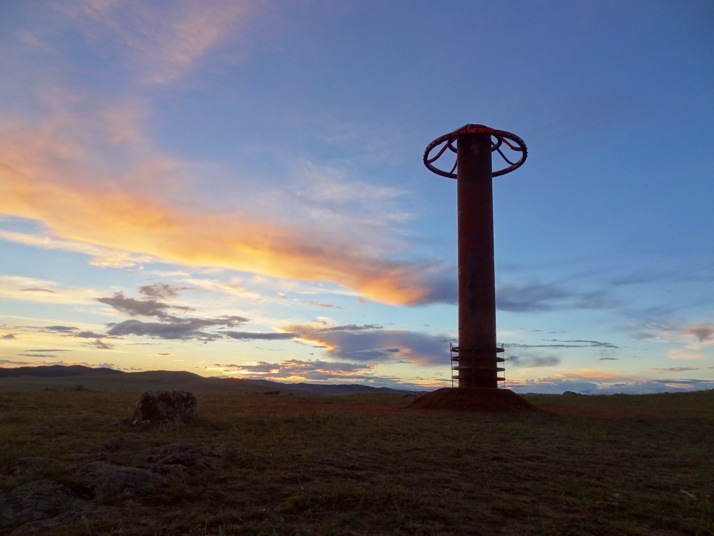 Nearby is an imperial ger’s roof centrepiece on a pole, complete with lights around the rim which sadly weren’t working
Nearby is an imperial ger’s roof centrepiece on a pole, complete with lights around the rim which sadly weren’t working
That night we made camp where a tributary joins the swollen Hurh river, and fell asleep imagining the sight of the great Mongol nation brought together almost 800 years ago.
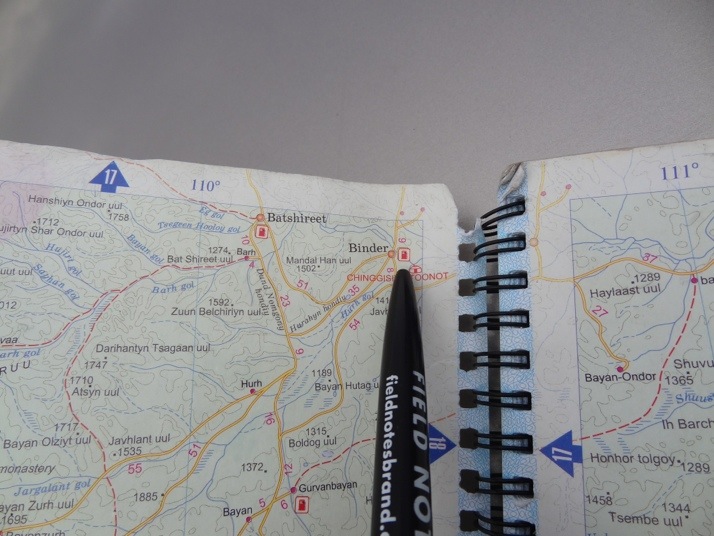 End of day 4, camping next to Hurh gol
End of day 4, camping next to Hurh gol
Day 5 – Dadal, 3 Stupas, Chinggis Monument, and 3 lakes
We got up around 7am to find Bacha had rigged up a shower using a bar of soap and 1.5ltr bottle of warm water wedged into the bullbars of his jeep, and it felt so nice to wash our hair! He’d been up again at 4am fly-fishing but had only caught twigs and bits of tree as the river was so swollen.
After a shallow crossing of the tributary we camped next to, we rounded a hill and descended towards the Horh river on a well-worn track that ends with a small manual ferry. As no-else turned up on our side before we set off, Bacha and I helped out pulling the nose of the ferry towards the far shore so the current did the hard work of moving us sideways.
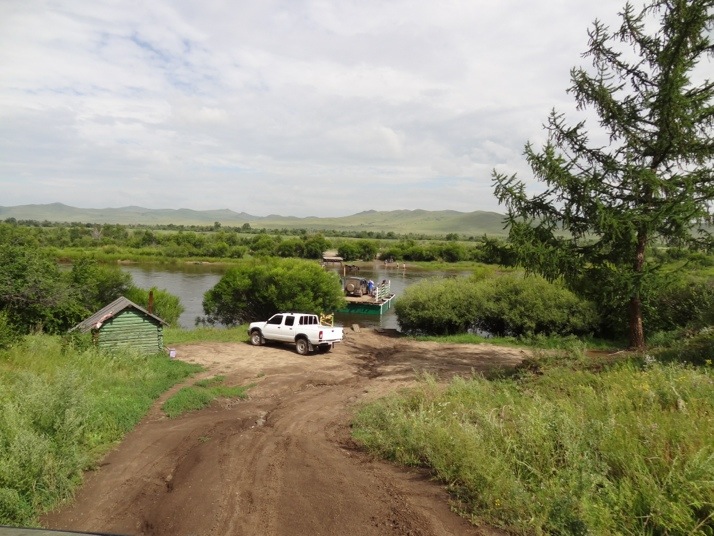 The cable ferry in action
The cable ferry in action
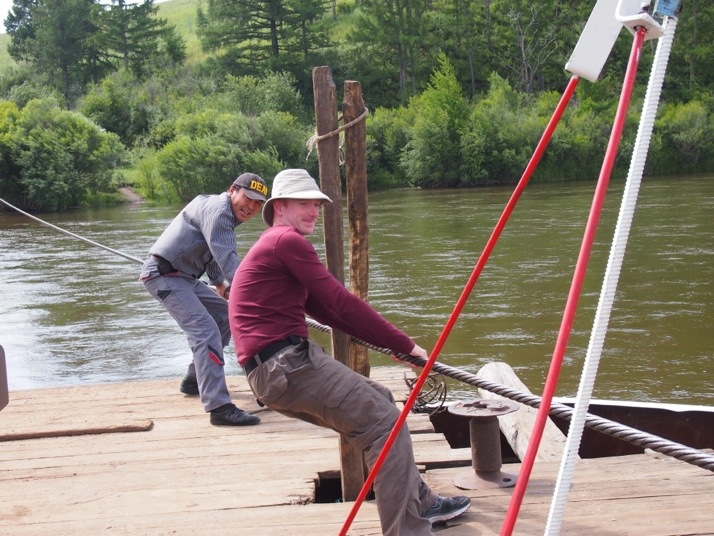 At times it didn’t feel like the river was doing most of the work!
At times it didn’t feel like the river was doing most of the work!
After more glorious scenery that you could wave a Wainwright walking stick at, we reached the largely Buryat inhabited town of Dadal, stark in its contrast to the rest of Mongolia as the dwellings are small wooden houses painted different shades of pastel colours. As we approached from the west, we stopped at the Stupa monument just a short distance from the town. Of the monument, our guidebook says:
On the western part of the village, this new memorial was built to honour the 607 people from Dadal who died in the political repression of the 1930s. The memorial contains three stupas and a list of the victims.
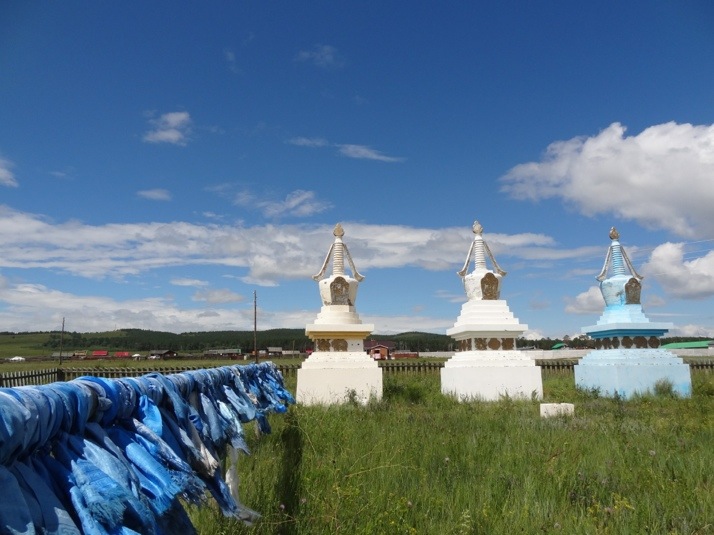 The Dadal Stupa Lama memorial
The Dadal Stupa Lama memorial
We stopped at a local shop and cleared out their stock of buuz which we ate in the car park of the town’s tourist camp, a strange place to stop admittedly, but it’s also home to a massive Chinggis Khaan monument. It’s not clear to us which came first – the monument or the camp.. suffice to say the monument has weathered better than some of the camp’s buildings!
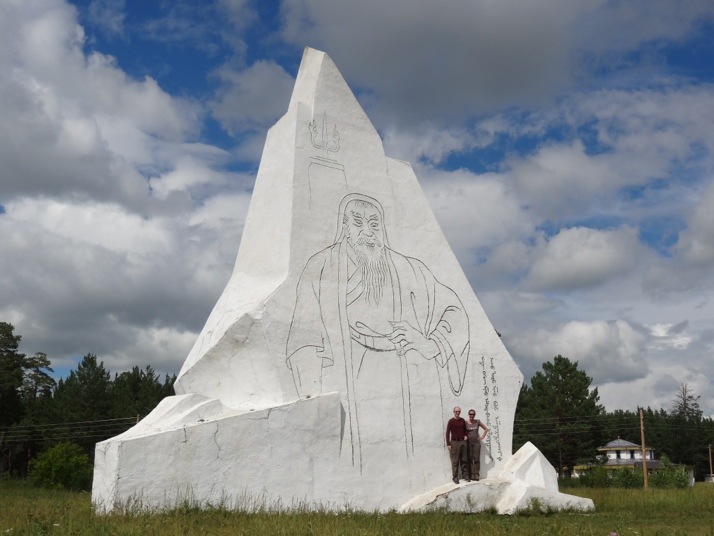 The Chinggis monument in Dadal. Built at the height of the communist era, the team that built it were killed, but the monument was allowed to stand. The camera is an 8 second sprint from the monument
The Chinggis monument in Dadal. Built at the height of the communist era, the team that built it were killed, but the monument was allowed to stand. The camera is an 8 second sprint from the monument
The Gurvan Nuur camp, as I’m sure you’ve worked out from its name if you’ve been paying attention, is situated next to a lake (Nuur = lake), which is actually one of three lakes that Saikhnaa from our guesthouse suggested we hike around while in Dadal.
The camp borders the two eastern-most lakes, and we were delighted to find loads of dragonflies right on the waters edge.
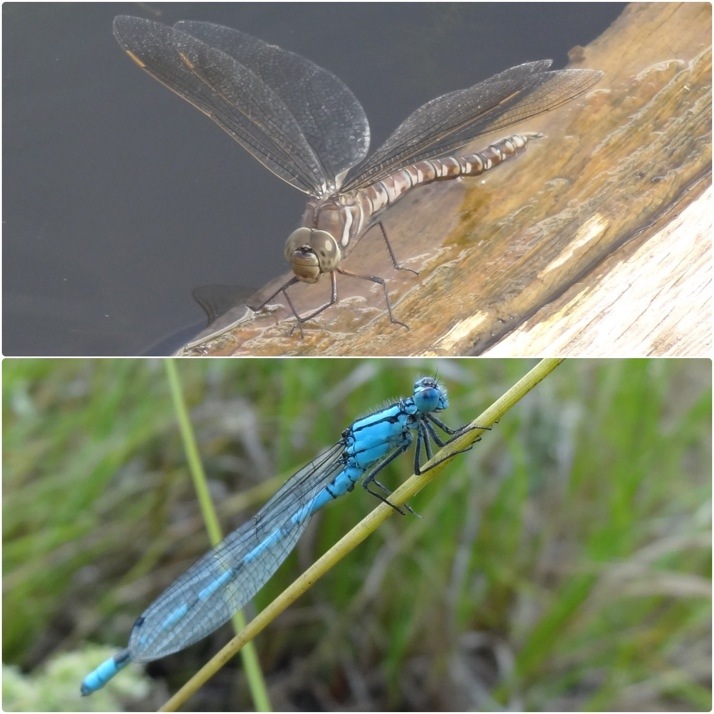 Beautiful dragonflies at the Dadal lakeside
Beautiful dragonflies at the Dadal lakeside
We found the lakeshore shrubbery too overgrown to walk through, and having left our herrings in the jeep, we turned back and through the camp to see the other two lakes – which get progressively smaller – the last one just looks like a fenced circle of reeds!
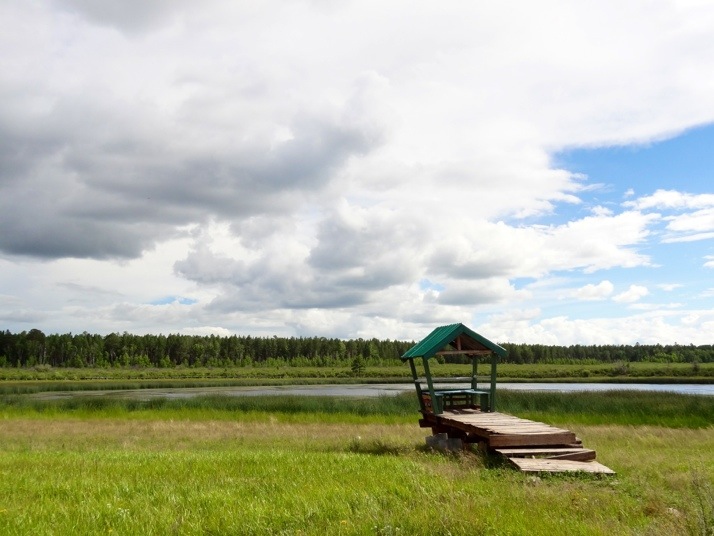 The second of the three lakes in Dadal
The second of the three lakes in Dadal
Our last stop which we spotted while looking for a camping site was, at first glance, an Ovoo on the top of a nearby hill. Bacha pointed his jeep at it and when we got there it turned out to be the stone marker erected in 1990 to commemorate the 750th anniversary of the writing of “The Secret History of the Mongols”..
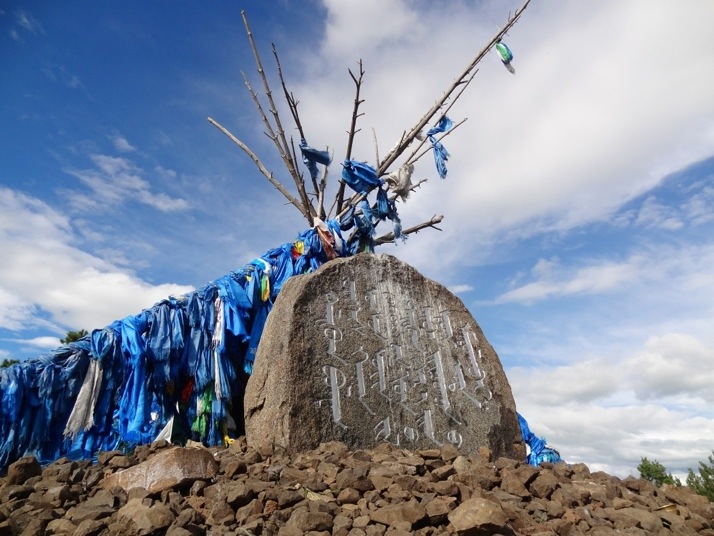 The inscription reads that Chinggis Khaan was born on this spot in 1162. The second line down from the left is “Chinggis Khaan” in Mongolian Uyghurjin script
The inscription reads that Chinggis Khaan was born on this spot in 1162. The second line down from the left is “Chinggis Khaan” in Mongolian Uyghurjin script
A little further through the Deluun Boldog range of hills, we found a spot a little further away from a river in the hopes we’d have fewer mosquitos to deal with. It was both picturesque and peaceful – a stunning area to grow up in.
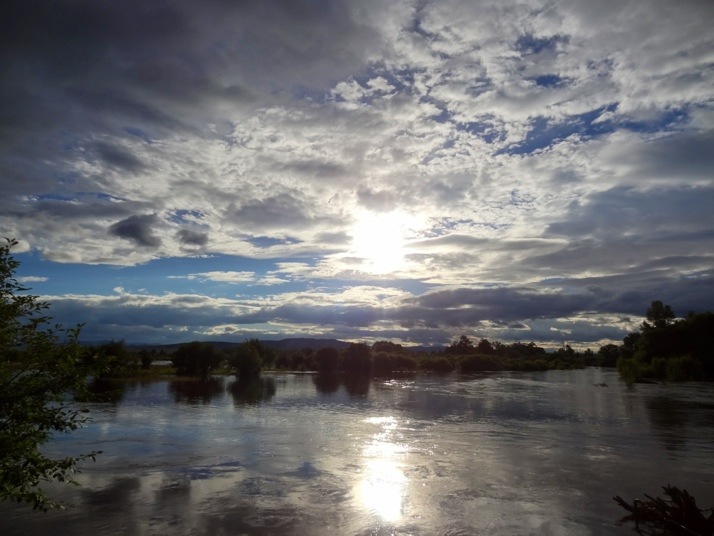 Sunset river view from our campsite near Dadal. If I’d grown up here, I doubt I’d need to conquer anywhere else on the planet. I would eventually loose my temper and nuke the mosquitos from orbit though
Sunset river view from our campsite near Dadal. If I’d grown up here, I doubt I’d need to conquer anywhere else on the planet. I would eventually loose my temper and nuke the mosquitos from orbit though
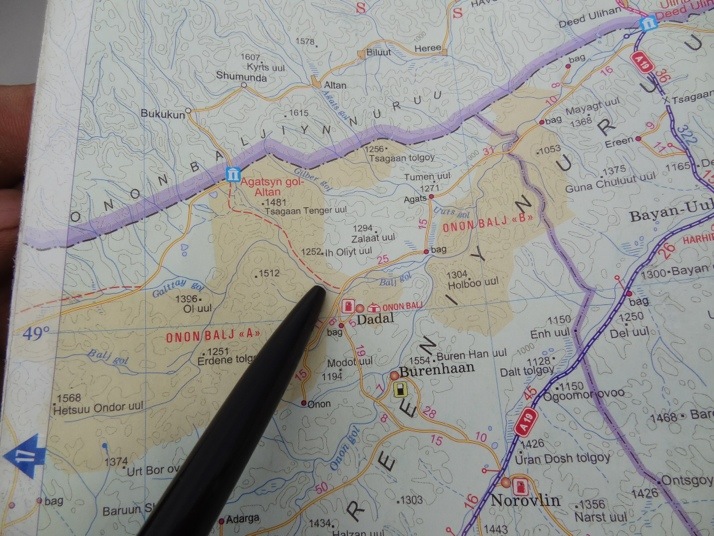 End of day 5, camping next to Balj gol, near Dadal
End of day 5, camping next to Balj gol, near Dadal
Day 6 – The 97 year-old’s Hunting Museum, and UB bound
For a change we were up and about before Bacha, so Julie decided to put her twist on his breakfast dish, as we had a long days drive ahead of us. Fully-fuelled, we had a couple of stops to make near Dadal before we headed back towards UB.
Listed in our guidebook, 94 year-old Zundoi-Davag has a barn at his homestead filled with animals he has hunted in the forests and hills around Dadal. Given both his age and the age of our guidebook, we were surprised and delighted to find Zundoi still very much alive and kicking, and he was genuinely touched that we’d taken the time to visit his trophy collection.
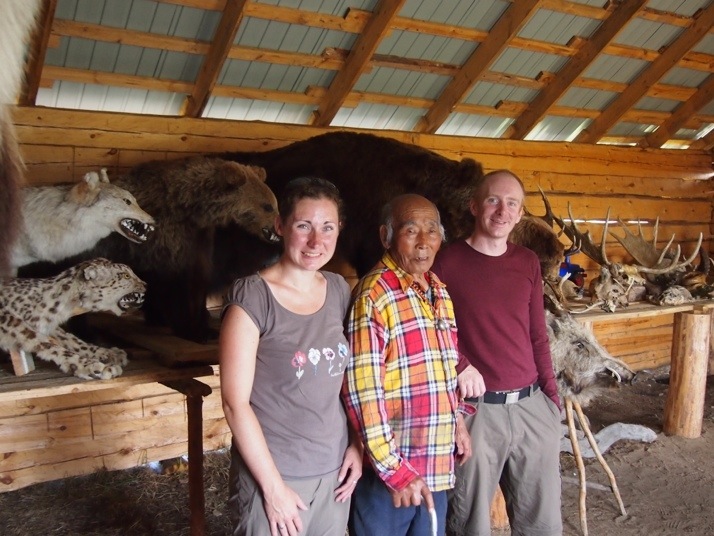 Us with the now 97 year-old Zundoi-Davag. His hearing’s going and he needs assistance to walk, but his mind is still sharp. His last kill was the brown bear behind us in 1978, and these days he’s an advocate of animal protection
Us with the now 97 year-old Zundoi-Davag. His hearing’s going and he needs assistance to walk, but his mind is still sharp. His last kill was the brown bear behind us in 1978, and these days he’s an advocate of animal protection
Our second and final Dadal stop was Kajuu Bulag, a cool, clear spring which is said to have been Chinggis Khaan’s watering hole. And by that I literally mean a hole with water coming out of it. After filling our water carriers, we drank from it too and it tasted deliciously cool and clear.
Our route south of Dadal took us past Norovlin which sits just next to a feature described in our tourist map as the “Wall of Chinggis Khaan”. This close to China (relatively speaking – bear with me on this..) the mind conjures up images of their Great Wall, but as you’ve likely never heard of a Mongol Great Wall as we hadn’t, and having read Conn Iggulden’s Conqueror series you know Chinggis favoured destroying walls rather than building them, so we were curious to see it. While stopping to fill up the jeep, Bacha asked where it was and was told “it’s just there“, “what, near the hill that’s about 1km away?”, “no, in this field just here, about 100 metres away“, “?!”.
With a full tank and empty stomachs, we hauled ourselves and our lunch-making equipment up the embankment and ate on the Wall of Chinggis Khaan..
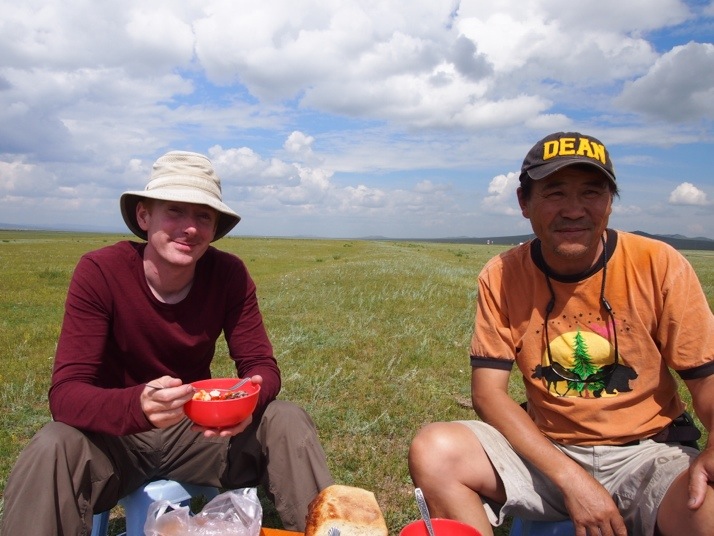 Bacha and I eating lunch on the Wall of Chinggis Khaan – can you see it? Turns out it’s a psychological offensive strategy. He’d line up his men along it and from a distance his enemies thought his numbers were greater
Bacha and I eating lunch on the Wall of Chinggis Khaan – can you see it? Turns out it’s a psychological offensive strategy. He’d line up his men along it and from a distance his enemies thought his numbers were greater
It was almost sunset as we hit the relieving flat tarmaced roads of Ondorhaan, and its rows of street lights painted different colours depending on the road. Civilisation! after days of dirt tracks, muddy puddles and river crossings. We picked up the Herlen river that passes to the south of the city, and joined the locals who were just packing up.
The tents went up and the fishing rod came out. Bacha was determined to catch something!
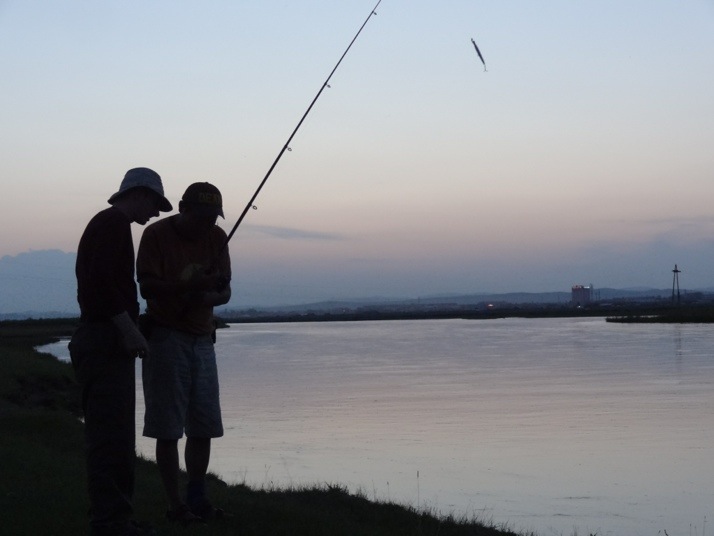 Fly-fishing with
Fly-fishing with J R Hartley Bacha. I didn’t catch anything either
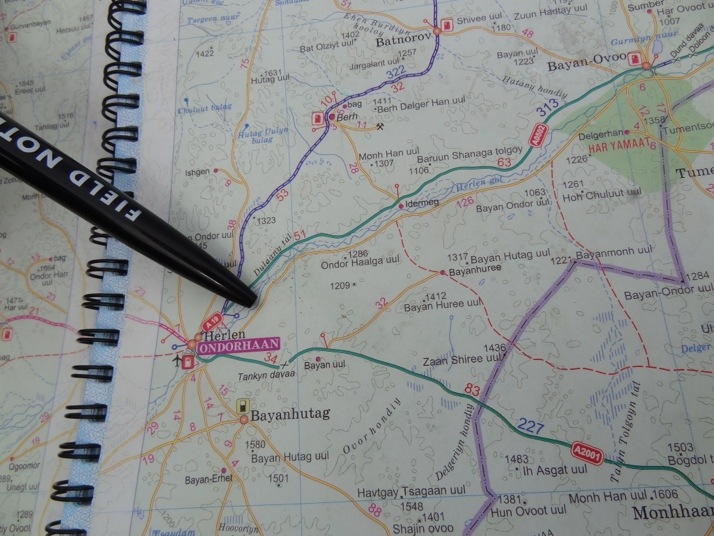 End of day 6, camping next to Herlen gol, Ondorhaan
End of day 6, camping next to Herlen gol, Ondorhaan
Day 7 – Horse riding in Ondorhaan, and back on proper roads!
We woke to a gloriously sunny day, and after a quick spot of breakfast Julie and I prepared ourselves for a spot of horse-riding. Although we’ve ridden camels twice now, we’ve heard many a story of how fast and how temperamental horses can be – given our camping field was covered in litter from the local picnickers the night before, I was reminded of my friend John who once rode a horse that nearly threw him off because it had caught sight of an intimidating crisp packet.
While we were both a little apprehensive, I decided to put it out of my mind by helping Bacha wash the last 6 days off his Land Cruiser, and as we were finishing up, a young lad from the nearby camp rode over on a horse.
A few words were exchanged and an agreement struck of 2-3 hours on a horse each with the young lad and his 2 brothers as guides. Another hour or so later and the boy returns with news that they only have one saddle between them, and his 2 brothers had gone into town – my dreams of galloping over the steppe were dashed. It seems we were to be led at walking pace along the riverbank instead. I think Julie was just as relieved as happy, and while she equated it to being on a donkey by the seaside, I have to say that once I got on I felt like John Wayne sidling into town from the wild, wild west. I still wonder what would have happened if I had shouted “choo” and got him up to a trot though.. :o)
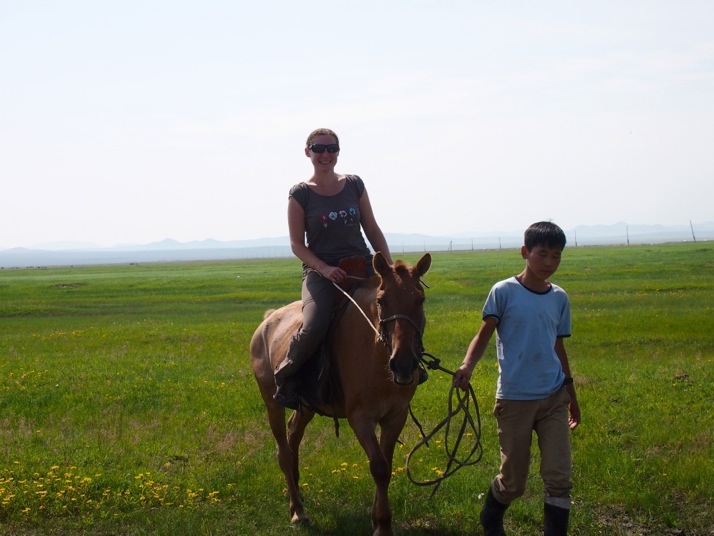 Cowgirl Julie
Cowgirl Julie
After half an hour and a couple of turns each, we decided we’d let the boy go home and gave him 3,000 MNT (£1.50) for putting up with us crazy foreigners.
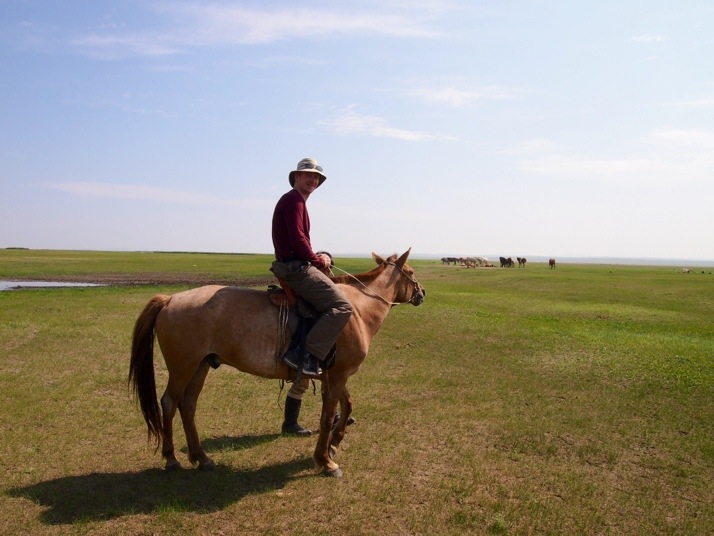 Cowboy Andrew
Cowboy Andrew
We’d spotted an interesting monument on the way past Ondorhaan sited next to their wrestling stadium yesterday. Bacha explained that it honours a local festival judge, and 6 Nadaam winning horses from this region of Mongolia.
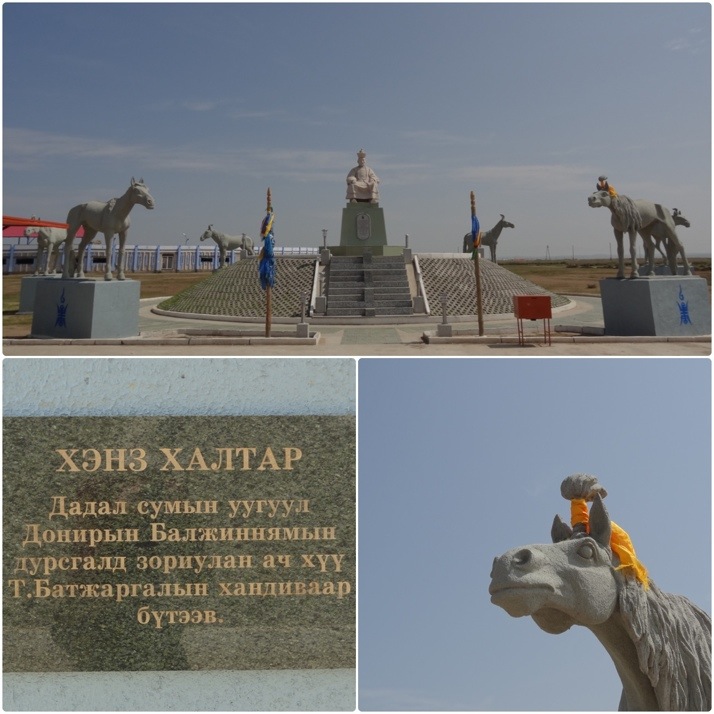 This horse is from Dadal (Дадал – if you recall your Cyrillic Russian ;)
This horse is from Dadal (Дадал – if you recall your Cyrillic Russian ;)
From Ondorhaan we picked up the main road back to UB, and as we were settling into speeds nearing 100km/hr rather than the 40-50km/hr we had managed on some of the lesser tracks, we came to an archway and had to visit the adjacent monument..
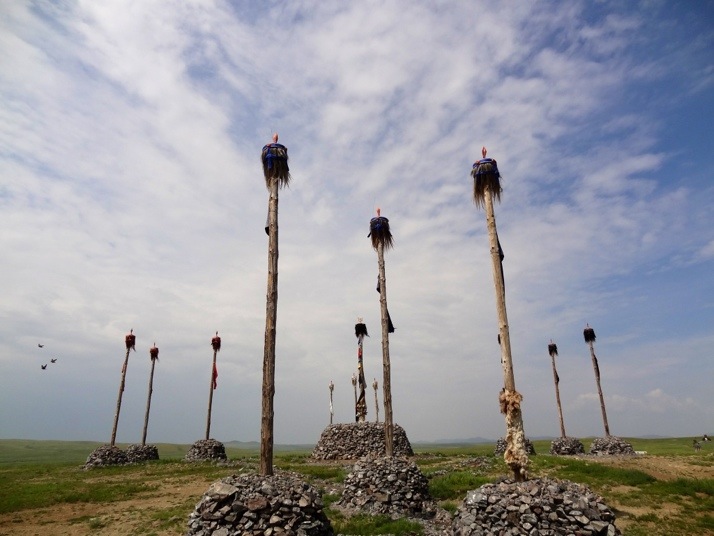 Monument of ‘tugs’ or banners
Monument of ‘tugs’ or banners
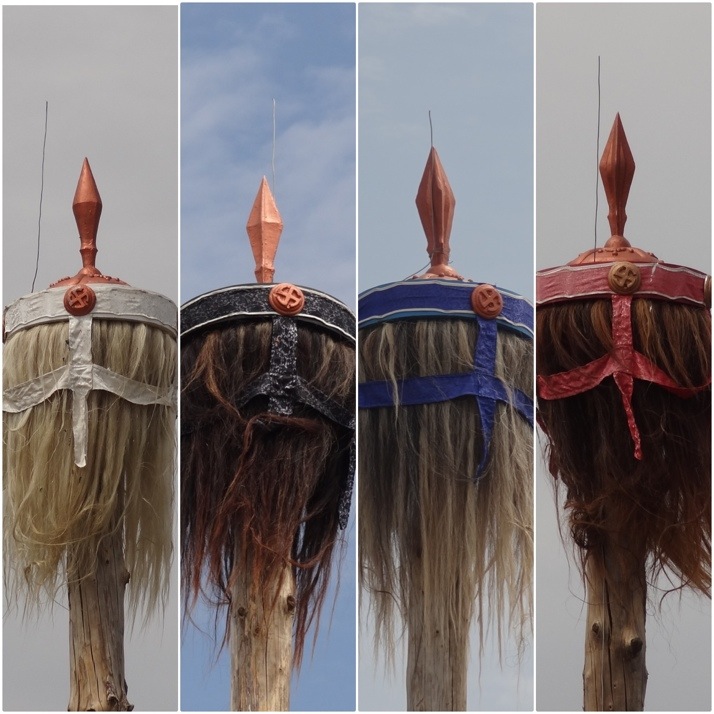 Close-up of the banners all made from horse or yak tail hair. White means peace, “royalty” or importance, black means war, and we don’t know what the red and blue ones mean! – if you do, let us know in the comments
Close-up of the banners all made from horse or yak tail hair. White means peace, “royalty” or importance, black means war, and we don’t know what the red and blue ones mean! – if you do, let us know in the comments
About an hour from the giant Chinggis statue we saw on day 3, we veered off-road to find a spot to settle down for the night, and, of all the places we pitched, this was my favourite. The lovely rolling hills reminded us of camping in the Lake District back home, and a gentle breeze kept the mosquitos away. A perfect last night’s camping.
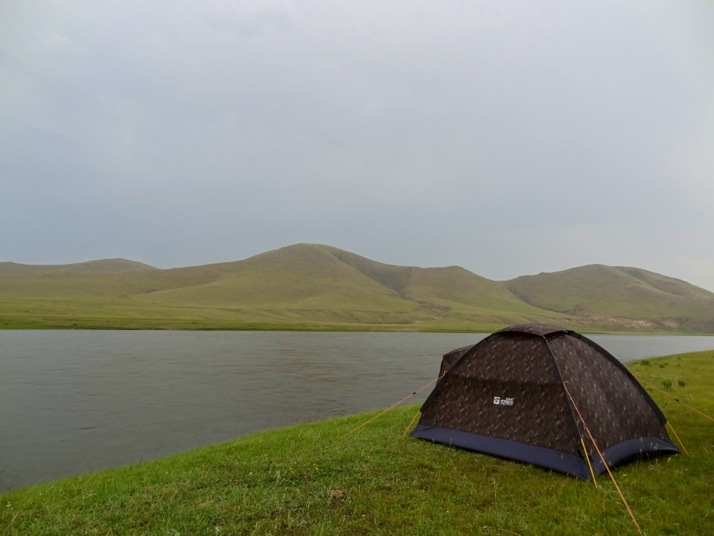 Our last night camping in the serene Mongolian steppe
Our last night camping in the serene Mongolian steppe
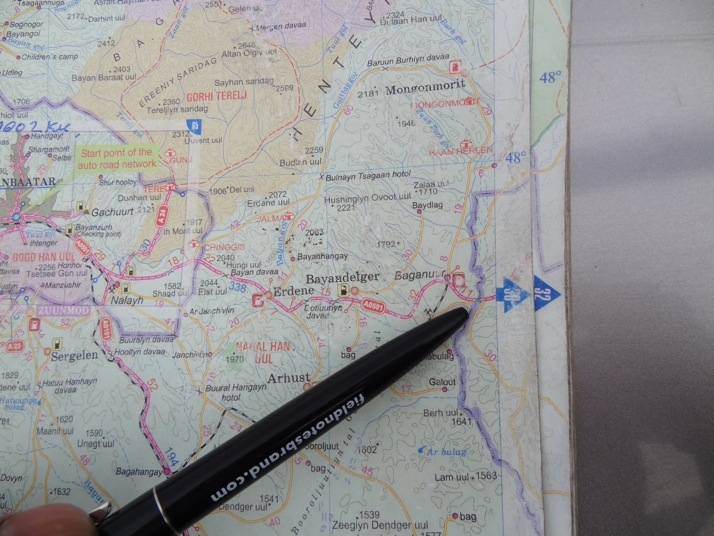 End of day 7, riverside camping near Baganuur
End of day 7, riverside camping near Baganuur
Day 8 – Birds, more birds, muddy roads and home
Bacha took the long way back to the main road in the hopes of seeing the ibex that live in the hills. After trying a few valleys we gave up the hunt to visit a nearby lake to do some birdwatching instead.
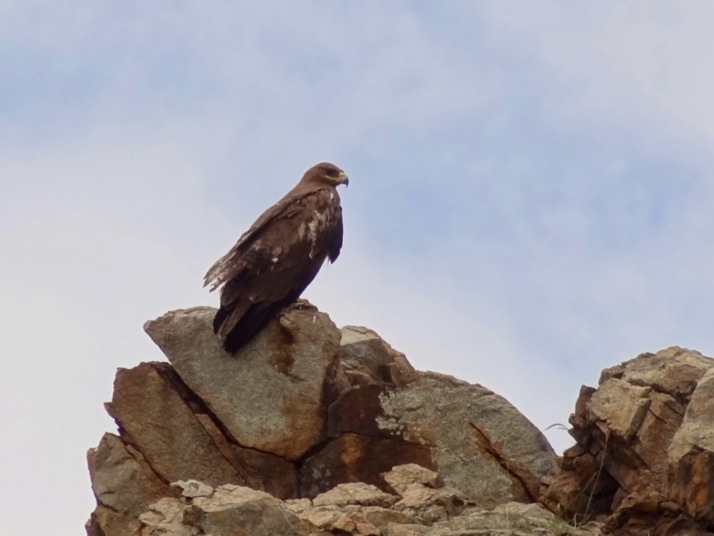 An eagle guards the entrance to our campsite, or is he just seeing us off the premises?
An eagle guards the entrance to our campsite, or is he just seeing us off the premises?
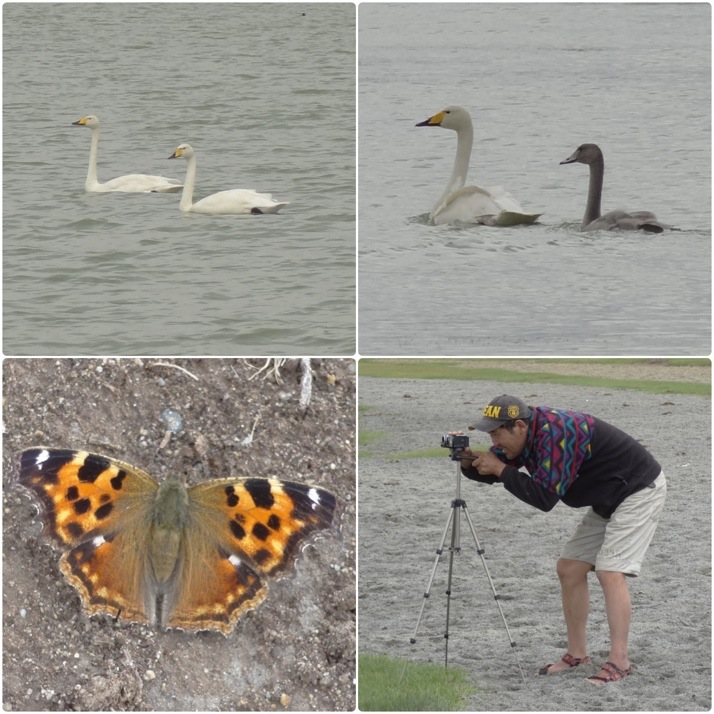 Swans, Swans, Butterflies and Bacha!
Swans, Swans, Butterflies and Bacha!
As we saw when we took the public buses to Kharkhorin and Zuunmod, the main roads are in an almost constant state of repair, and with the recent bad weather, the detours were very slippery indeed..
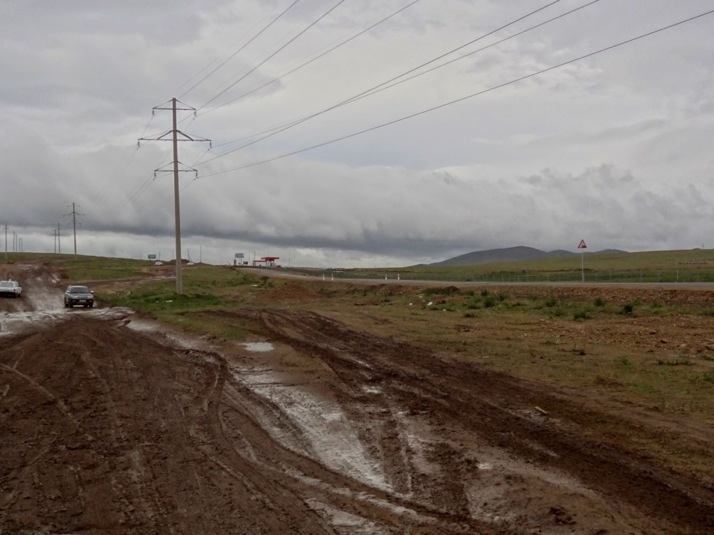 The mud-slick detour – we’d wondered why the cars coming out of the city were dirtier than the ones going into it!
The mud-slick detour – we’d wondered why the cars coming out of the city were dirtier than the ones going into it!
We waved to the great Chinggis as we passed, a fitting marker for both the start and end of our epic journey to his birthplace. Bayarlalaa.
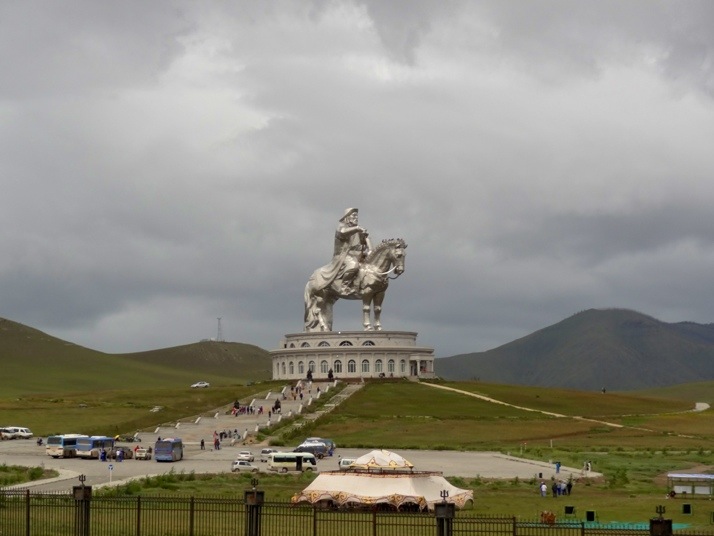 Had it only been 5 days since we saw him last?
Had it only been 5 days since we saw him last?
Epilogue
Our immeasurable thanks to the funny and fun-loving Bacha and his more than capable Land Cruiser, and to Saikhnaa, Temuulen & Yesukhei of the Chinggis guesthouse for their help in organising and arranging our tour.
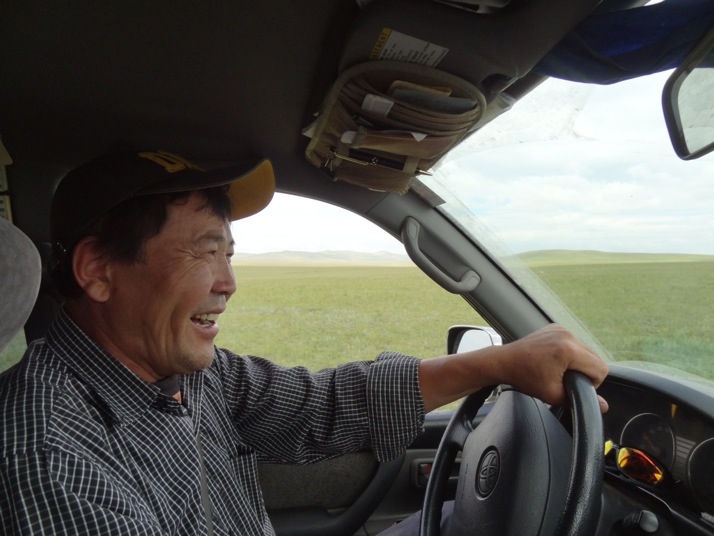 Bacha, our Mongolian grandfather whose name means shepherd. He certainly looked after us!
Bacha, our Mongolian grandfather whose name means shepherd. He certainly looked after us!
If you’d like to venture off the beaten tourist tracks, we can highly recommend the Chinggis guesthouse whether you’re staying there or not. As Bacha speaks 5 languages including English and German and was a fantastic guide, I daresay you could contact him directly :) (email us for his details – I don’t want to put them up here!)
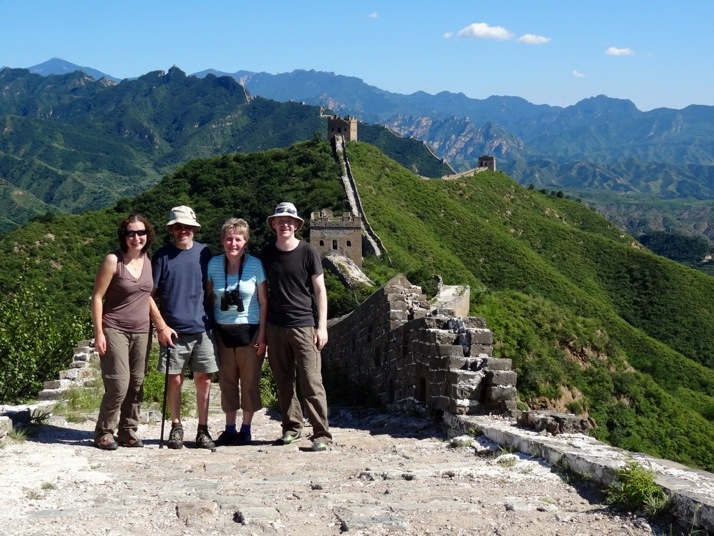 Us on The Great Wall of China with Julie’s parents, Norman and Moira. The Sīmatái section snakes over the ridge of hills in the distance
Us on The Great Wall of China with Julie’s parents, Norman and Moira. The Sīmatái section snakes over the ridge of hills in the distance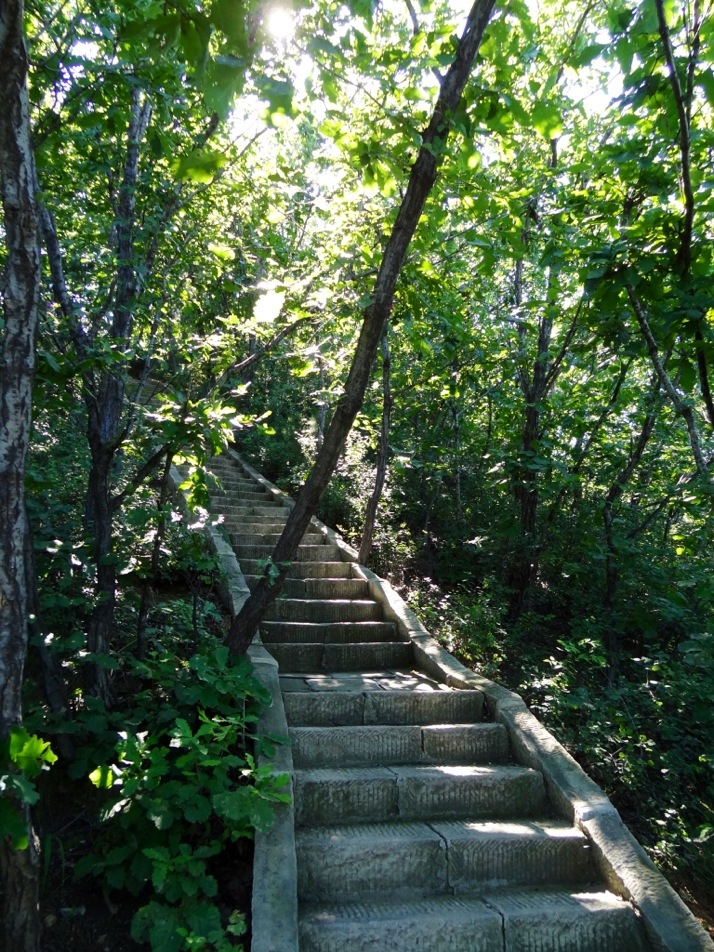 The hiking trail up to The Great Wall
The hiking trail up to The Great Wall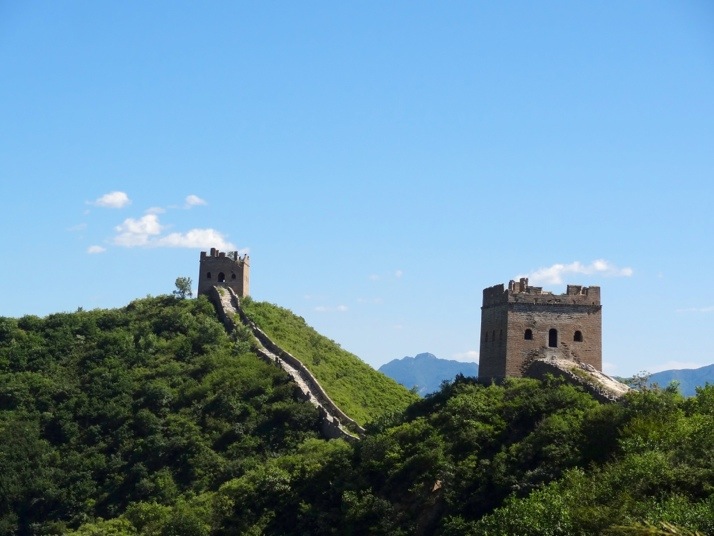 The view teasing us through the forest as we climbed – “East Tower with five holes” in the foreground, and “Qilin Tower” behind
The view teasing us through the forest as we climbed – “East Tower with five holes” in the foreground, and “Qilin Tower” behind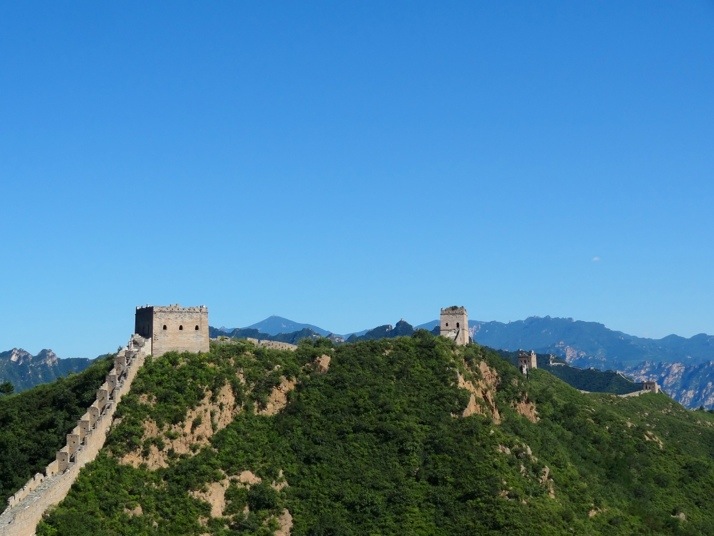 A very steep section of the Jīnshānling Great Wall – the “steps” up to the tower are over knee height
A very steep section of the Jīnshānling Great Wall – the “steps” up to the tower are over knee height The descent into “Flowers Tower”, the furthest point Julie and I reached before we had to turn back
The descent into “Flowers Tower”, the furthest point Julie and I reached before we had to turn back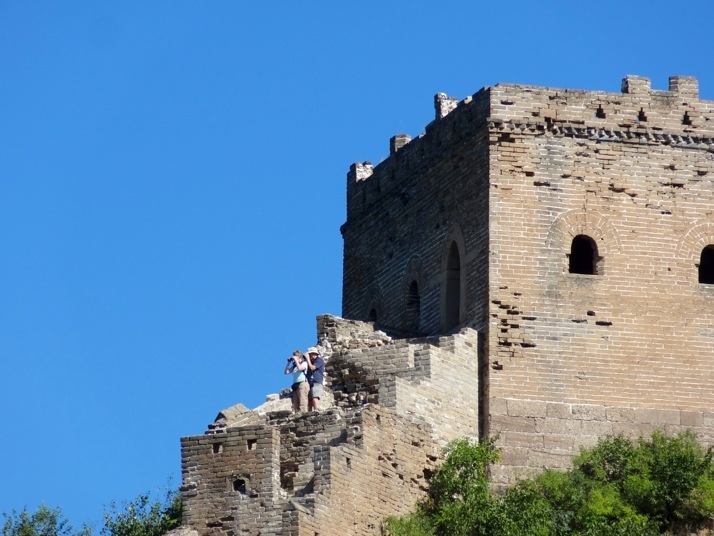 Norman and Moira had stopped back to do a spot of bird watching
Norman and Moira had stopped back to do a spot of bird watching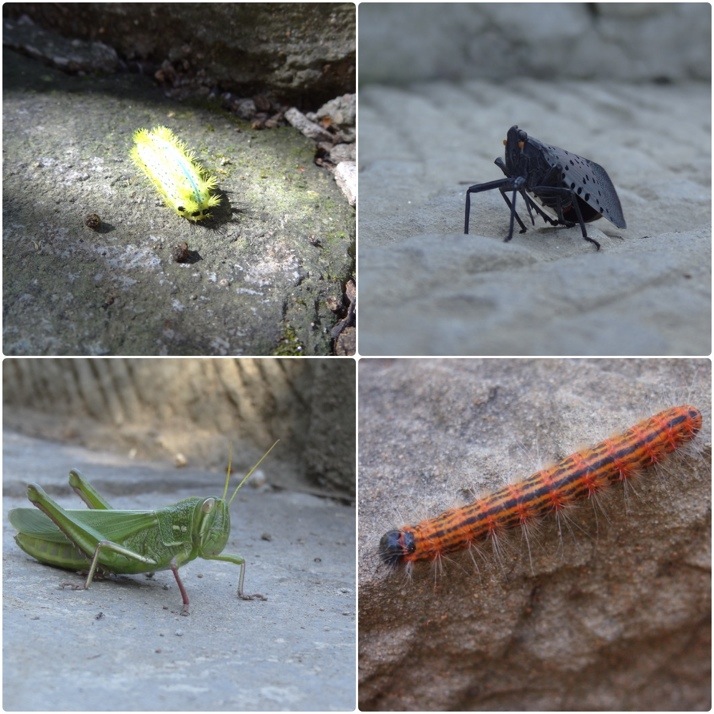 The birds were too quick to photograph, but there were plenty of insects, including a giant grasshopper (there’s an ant by its foot to give you a sense of scale – can you see it?)
The birds were too quick to photograph, but there were plenty of insects, including a giant grasshopper (there’s an ant by its foot to give you a sense of scale – can you see it?)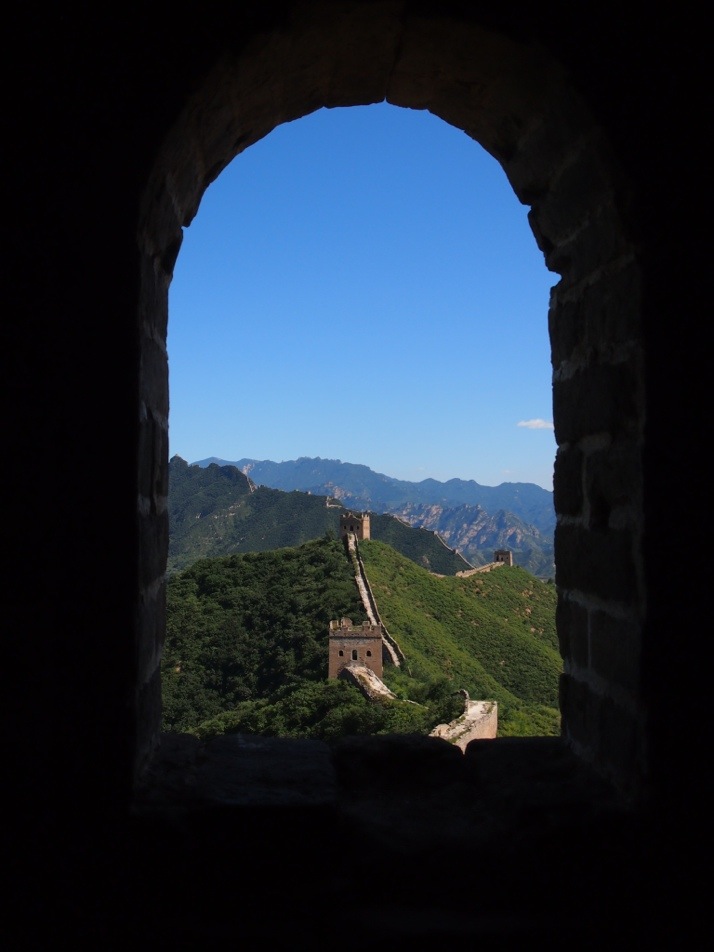

 two year trip
two year trip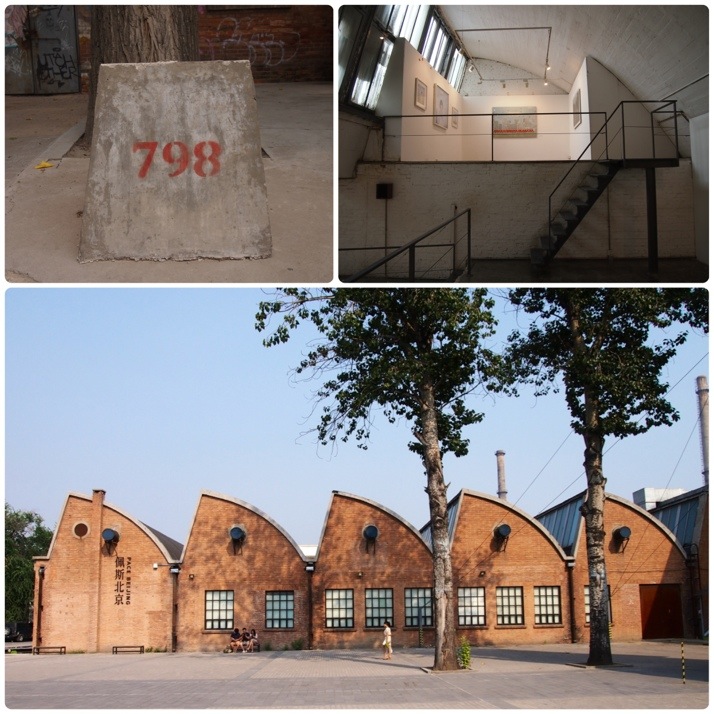
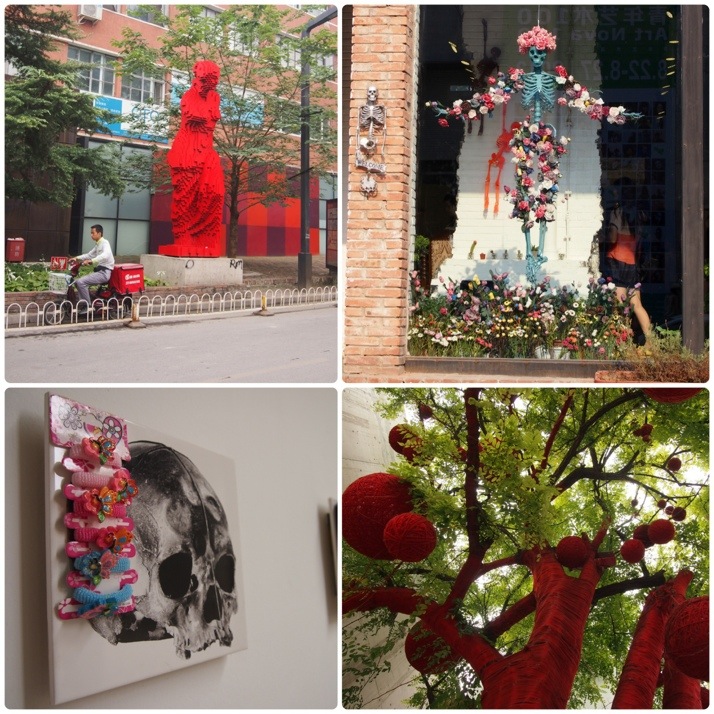
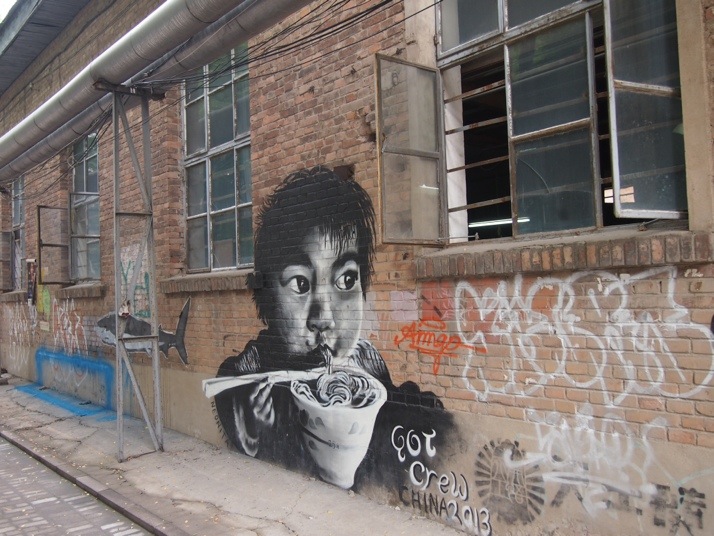
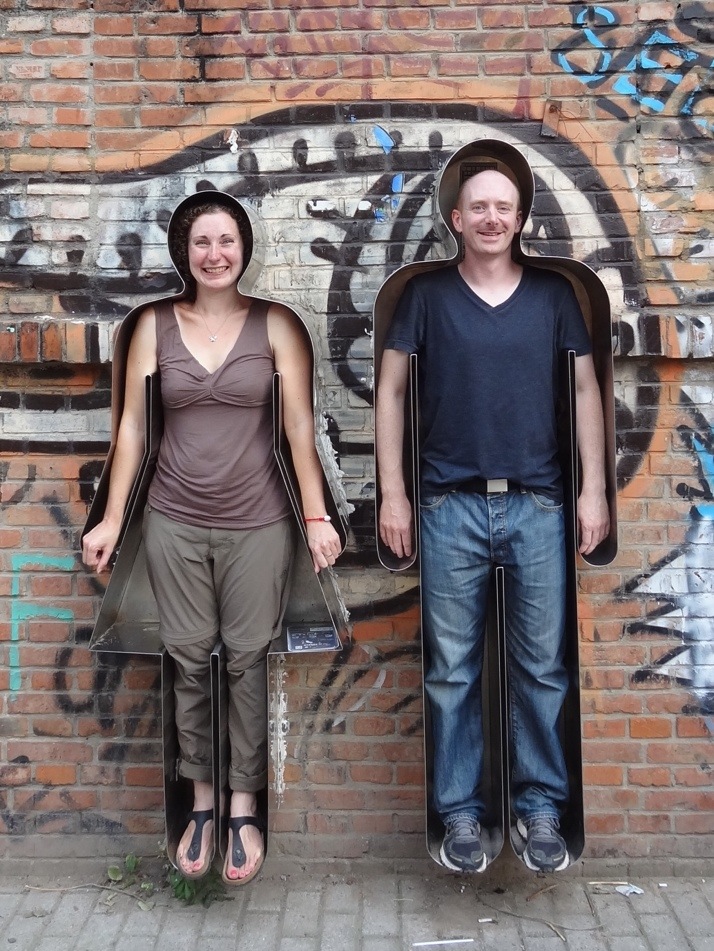
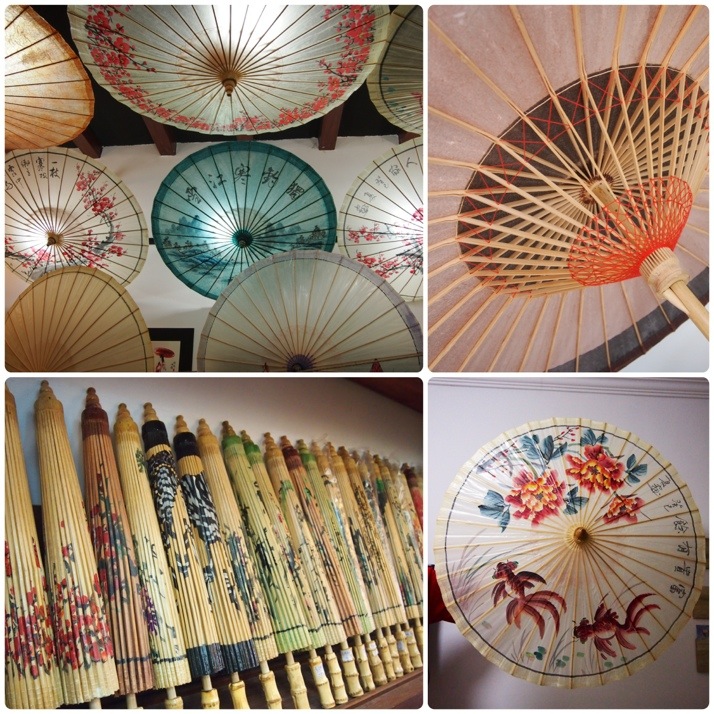
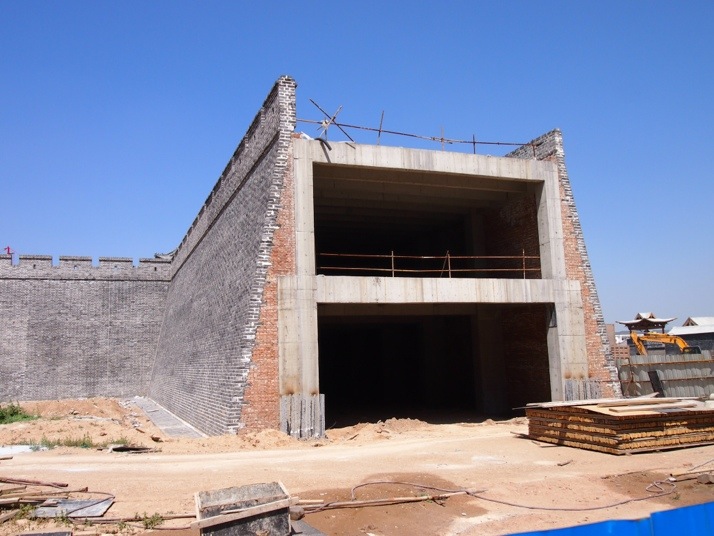
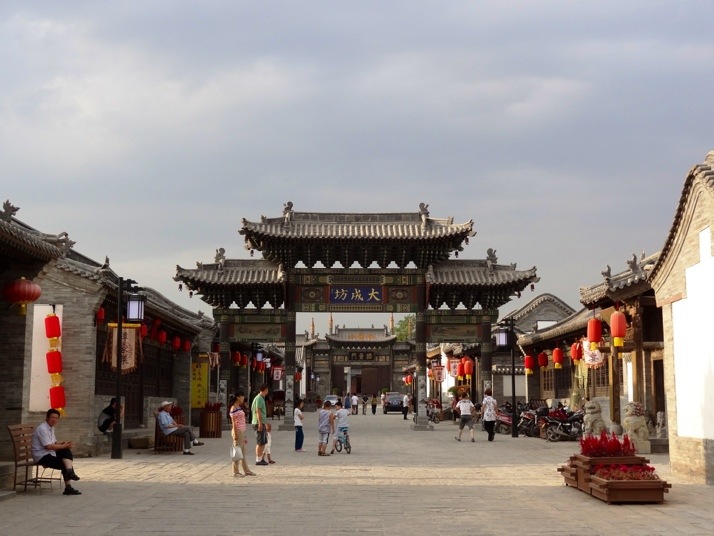
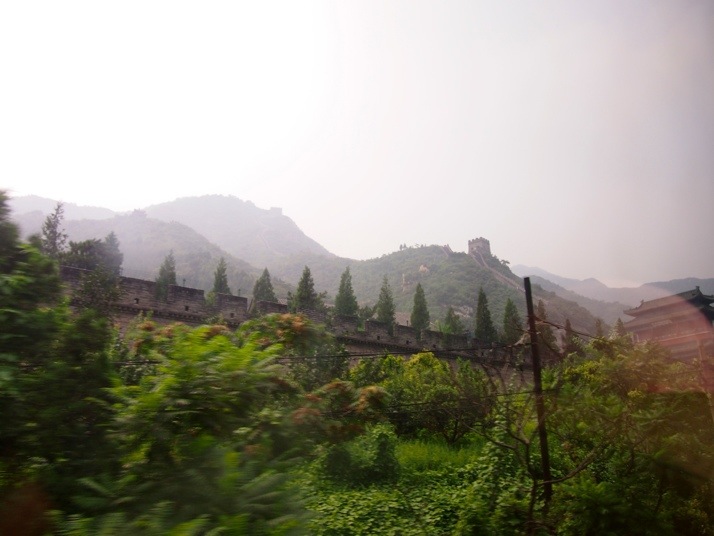
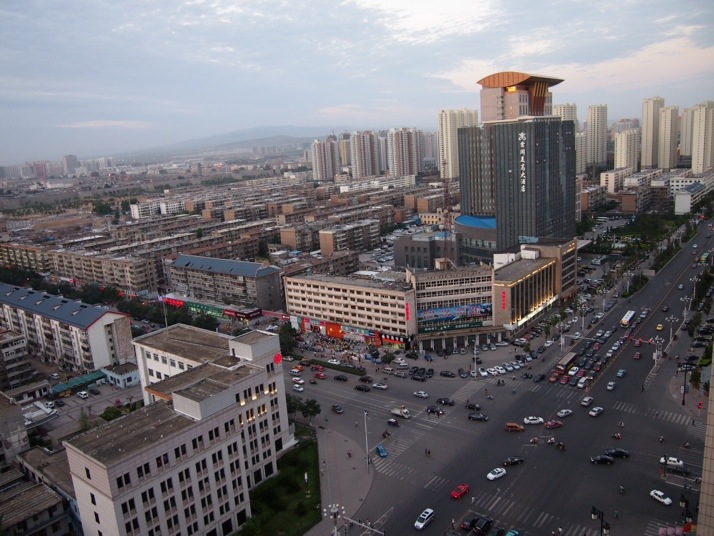
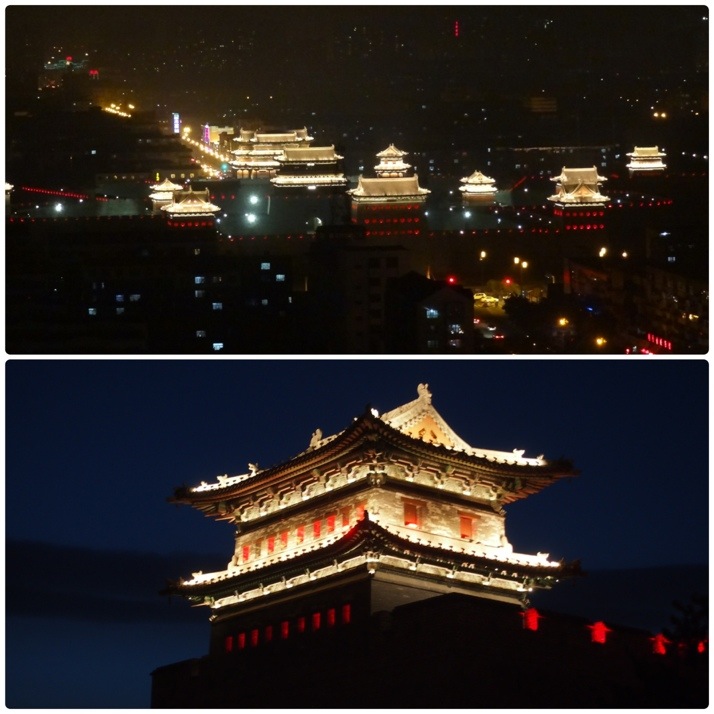
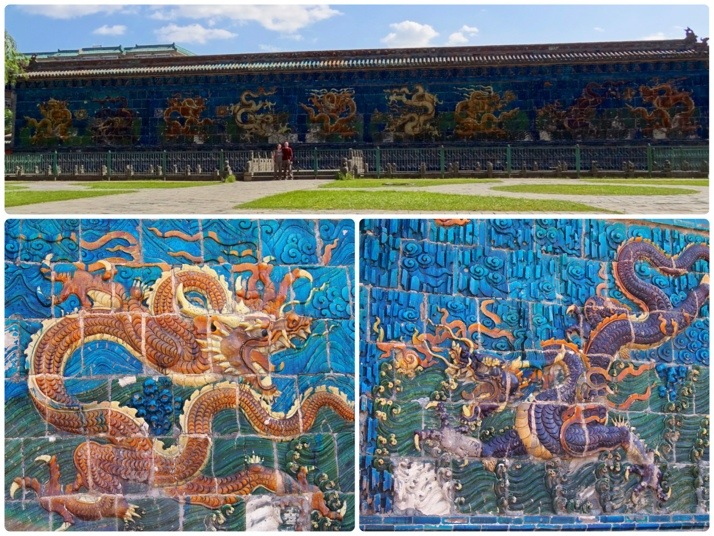
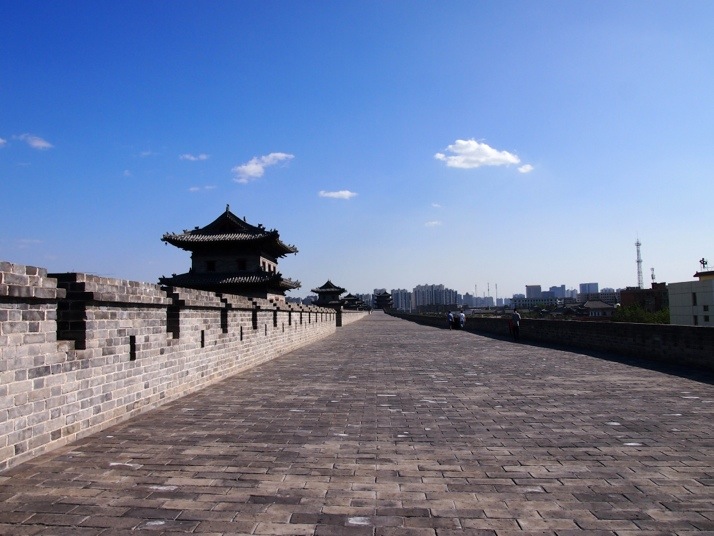
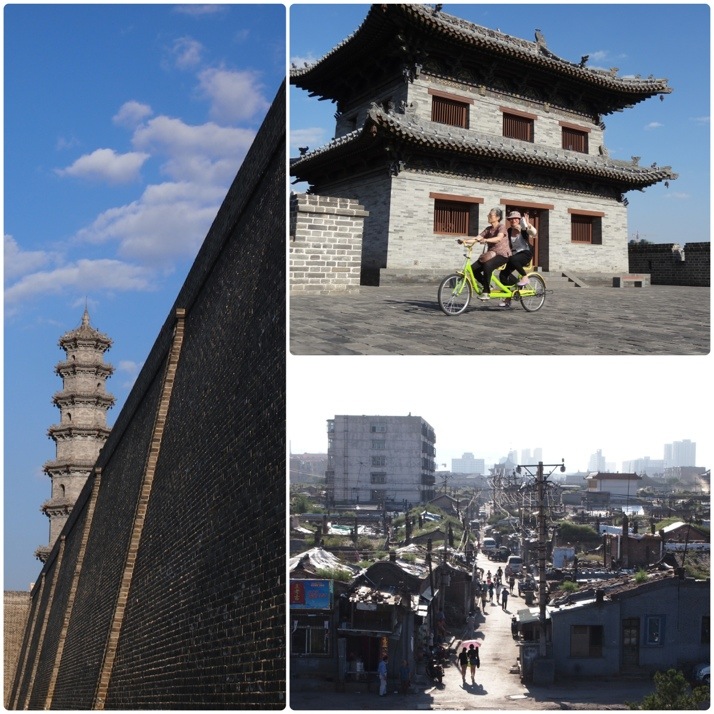
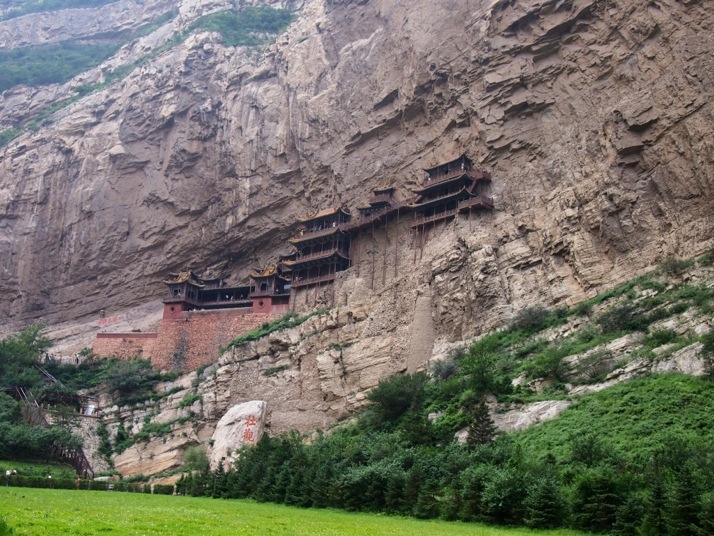
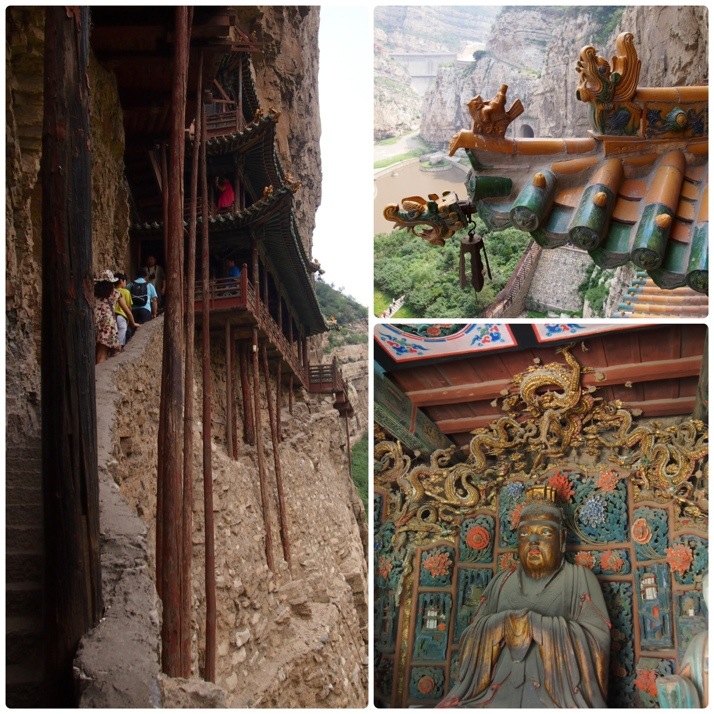
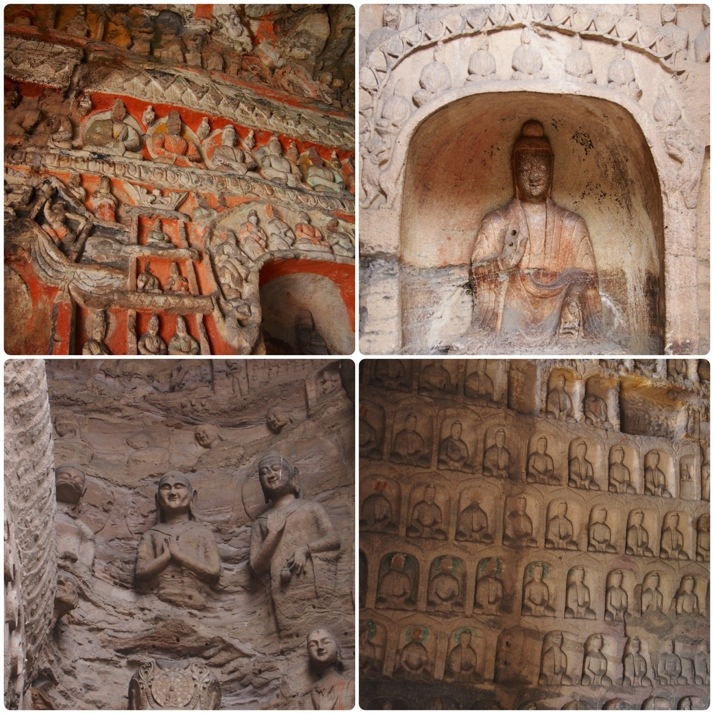
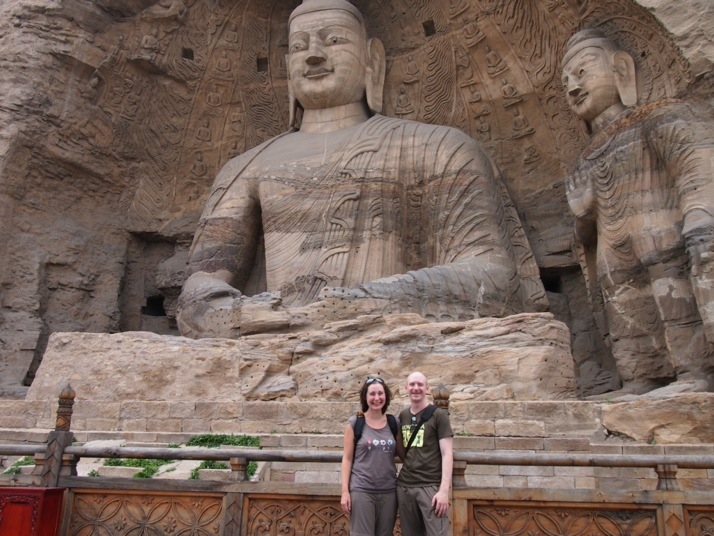
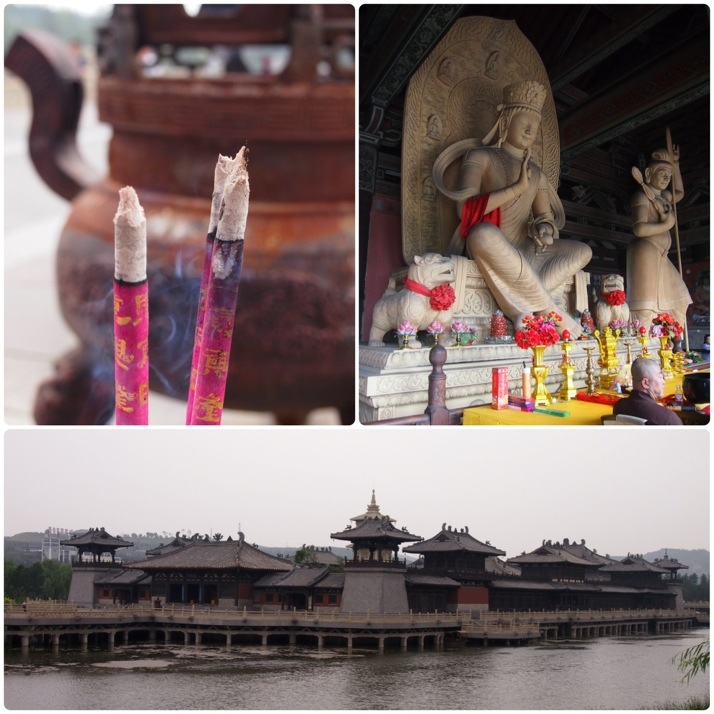
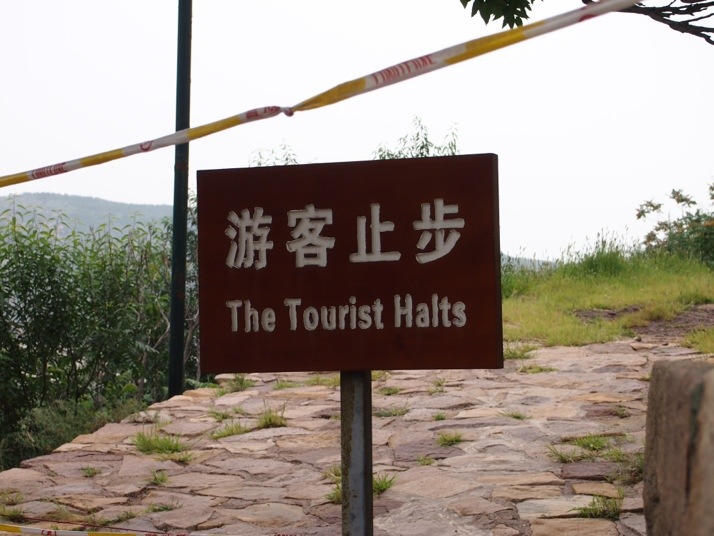
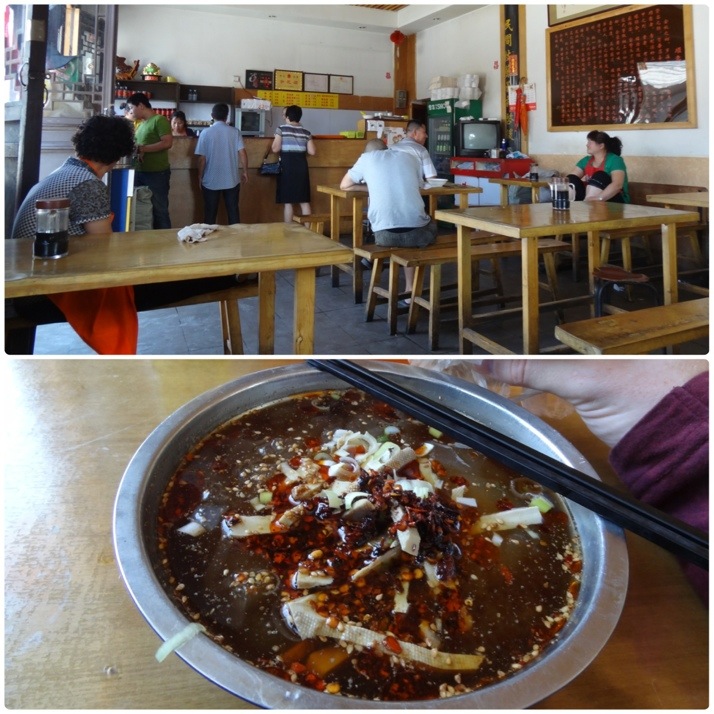
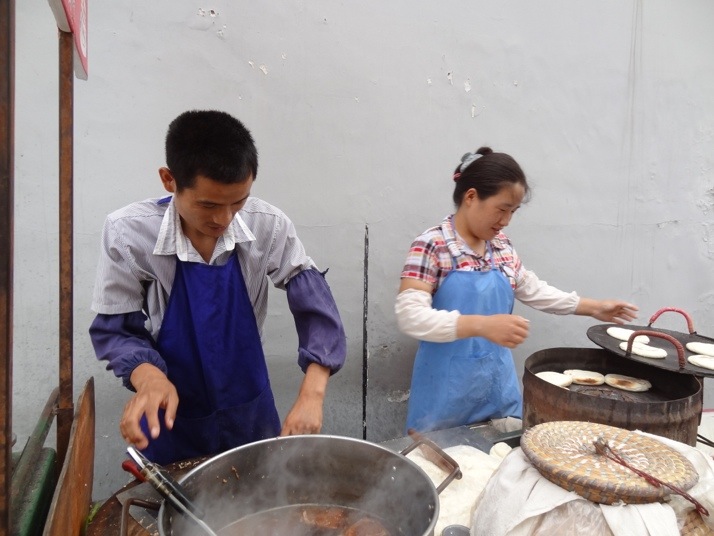
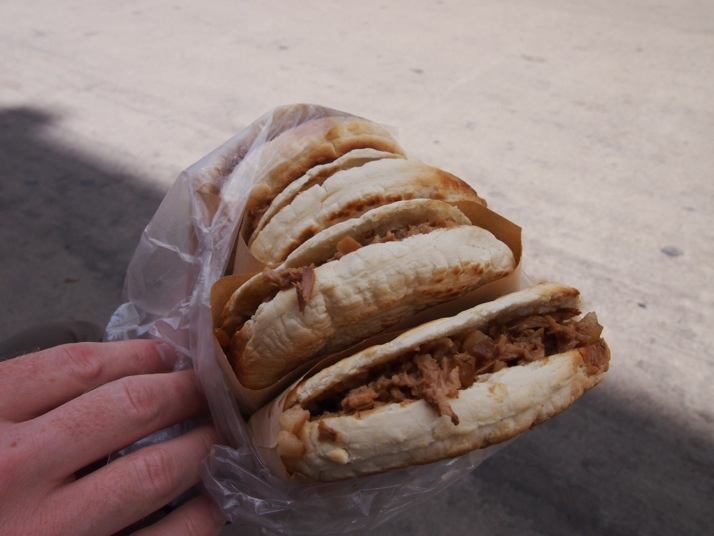
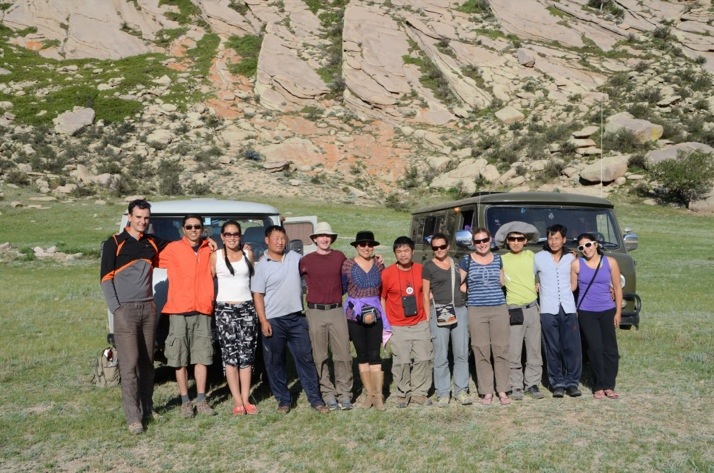
 Packing the Land Cruiser for adventure! Left to Right: Bacha our driver, Temuulen (Saikhnaa’s daughter and Yesukhei’s little sister who almost single-handedly runs the guest house), Julie and Yesukhei
Packing the Land Cruiser for adventure! Left to Right: Bacha our driver, Temuulen (Saikhnaa’s daughter and Yesukhei’s little sister who almost single-handedly runs the guest house), Julie and Yesukhei Entrance to
Entrance to  Us inside the Lama hideout, hiding out
Us inside the Lama hideout, hiding out Climbing the Turtle
Climbing the Turtle The walk to Monastery includes a little rope-bridge
The walk to Monastery includes a little rope-bridge After a long walk uphill, we were rewarded with a long staircase that was built to resemble the trunk of a White Elephant
After a long walk uphill, we were rewarded with a long staircase that was built to resemble the trunk of a White Elephant The Monastery is light and brightly painted inside
The Monastery is light and brightly painted inside Yesukhei comatose after a morning’s guiding
Yesukhei comatose after a morning’s guiding Stunning views of the valley from the top of the hill. Our campsite is the white dot at the bottom centre
Stunning views of the valley from the top of the hill. Our campsite is the white dot at the bottom centre We stopped on the way up and the way down to photograph some of the interesting flora
We stopped on the way up and the way down to photograph some of the interesting flora End of day 1, camping in Gorkhi-Terelj National Park
End of day 1, camping in Gorkhi-Terelj National Park Bacha imitating the call of a powerful bull, quite successfully too as a cow starts sniffing around his tent
Bacha imitating the call of a powerful bull, quite successfully too as a cow starts sniffing around his tent Our guide for the day. Julie named him Chinggis
Our guide for the day. Julie named him Chinggis View of the top. Those dark clouds looking awfully close
View of the top. Those dark clouds looking awfully close View from the top, before the rains came in
View from the top, before the rains came in Us in front of the massive metal monument to Chinggis Khaan, a couple of hours east of UB
Us in front of the massive metal monument to Chinggis Khaan, a couple of hours east of UB Us on Chinggis Khaan’s horse’s head!
Us on Chinggis Khaan’s horse’s head! Us at Khökh Nuur, site of Temujin naming himself Chinggis Khaan
Us at Khökh Nuur, site of Temujin naming himself Chinggis Khaan The Khökh Nuur extortion racket (according to our guidebook). Not sure I’d argue with their park “entrance” fee, as they do look somewhat official
The Khökh Nuur extortion racket (according to our guidebook). Not sure I’d argue with their park “entrance” fee, as they do look somewhat official End of day 3, camping next to Khökh Nuur (blue lake)
End of day 3, camping next to Khökh Nuur (blue lake) Bacha’s breakfast. Mmmm, tasty!
Bacha’s breakfast. Mmmm, tasty! MARMOT!
MARMOT! Stunningly vast and empty Mongolian scenery
Stunningly vast and empty Mongolian scenery The smaller temple to the left, just as the rain starts again
The smaller temple to the left, just as the rain starts again Me walking into the side entrance of the re-built main temple, seeking solace from the weather
Me walking into the side entrance of the re-built main temple, seeking solace from the weather Clockwise, from top-left: Remains of an old temple that still contains a tiny Buddha statue; Interesting flora behind the main temple; Large Buddha statue; View of the Monastery from the hillside in the rain; A colourful Buddha near the grounds entrance; A painted rock-face sign and view of the lake opposite of the Monastery
Clockwise, from top-left: Remains of an old temple that still contains a tiny Buddha statue; Interesting flora behind the main temple; Large Buddha statue; View of the Monastery from the hillside in the rain; A colourful Buddha near the grounds entrance; A painted rock-face sign and view of the lake opposite of the Monastery 10 people, with luggage? No wonder they got stuck!
10 people, with luggage? No wonder they got stuck! Our van from the kitchen window
Our van from the kitchen window A family of Cranes, spotted on our way to Öglögchiin Kherem
A family of Cranes, spotted on our way to Öglögchiin Kherem The view up the hillside from where we turned back
The view up the hillside from where we turned back The challenge!
The challenge! At the top! (well, as far as I could go without climbing gear or a ladder!)
At the top! (well, as far as I could go without climbing gear or a ladder!) Left: a snake disappearing into the rocks we were climbing down; Right: Likely it’s former winter coat
Left: a snake disappearing into the rocks we were climbing down; Right: Likely it’s former winter coat The inscription explains that this was the site where Chinggis Khaan united the heads of the Mongol tribes into a single nation
The inscription explains that this was the site where Chinggis Khaan united the heads of the Mongol tribes into a single nation Nearby is an imperial ger’s roof centrepiece on a pole, complete with lights around the rim which sadly weren’t working
Nearby is an imperial ger’s roof centrepiece on a pole, complete with lights around the rim which sadly weren’t working End of day 4, camping next to Hurh gol
End of day 4, camping next to Hurh gol The cable ferry in action
The cable ferry in action At times it didn’t feel like the river was doing most of the work!
At times it didn’t feel like the river was doing most of the work! The Dadal Stupa Lama memorial
The Dadal Stupa Lama memorial The Chinggis monument in Dadal. Built at the height of the communist era, the team that built it were killed, but the monument was allowed to stand. The camera is an 8 second sprint from the monument
The Chinggis monument in Dadal. Built at the height of the communist era, the team that built it were killed, but the monument was allowed to stand. The camera is an 8 second sprint from the monument Beautiful dragonflies at the Dadal lakeside
Beautiful dragonflies at the Dadal lakeside The second of the three lakes in Dadal
The second of the three lakes in Dadal The inscription reads that Chinggis Khaan was born on this spot in 1162. The second line down from the left is “Chinggis Khaan” in
The inscription reads that Chinggis Khaan was born on this spot in 1162. The second line down from the left is “Chinggis Khaan” in  Sunset river view from our campsite near Dadal. If I’d grown up here, I doubt I’d need to conquer anywhere else on the planet. I would eventually loose my temper and nuke the mosquitos from orbit though
Sunset river view from our campsite near Dadal. If I’d grown up here, I doubt I’d need to conquer anywhere else on the planet. I would eventually loose my temper and nuke the mosquitos from orbit though End of day 5, camping next to Balj gol, near Dadal
End of day 5, camping next to Balj gol, near Dadal Us with the now 97 year-old Zundoi-Davag. His hearing’s going and he needs assistance to walk, but his mind is still sharp. His last kill was the brown bear behind us in 1978, and these days he’s an advocate of animal protection
Us with the now 97 year-old Zundoi-Davag. His hearing’s going and he needs assistance to walk, but his mind is still sharp. His last kill was the brown bear behind us in 1978, and these days he’s an advocate of animal protection Bacha and I eating lunch on the Wall of Chinggis Khaan – can you see it? Turns out it’s a psychological offensive strategy. He’d line up his men along it and from a distance his enemies thought his numbers were greater
Bacha and I eating lunch on the Wall of Chinggis Khaan – can you see it? Turns out it’s a psychological offensive strategy. He’d line up his men along it and from a distance his enemies thought his numbers were greater Fly-fishing with
Fly-fishing with  End of day 6, camping next to Herlen gol, Ondorhaan
End of day 6, camping next to Herlen gol, Ondorhaan Cowgirl Julie
Cowgirl Julie Cowboy Andrew
Cowboy Andrew This horse is from Dadal (Дадал –
This horse is from Dadal (Дадал –  Monument of ‘tugs’ or banners
Monument of ‘tugs’ or banners Close-up of the banners all made from horse or yak tail hair. White means peace, “royalty” or importance, black means war, and we don’t know what the red and blue ones mean! – if you do, let us know in the comments
Close-up of the banners all made from horse or yak tail hair. White means peace, “royalty” or importance, black means war, and we don’t know what the red and blue ones mean! – if you do, let us know in the comments Our last night camping in the serene Mongolian steppe
Our last night camping in the serene Mongolian steppe End of day 7, riverside camping near Baganuur
End of day 7, riverside camping near Baganuur An eagle guards the entrance to our campsite, or is he just seeing us off the premises?
An eagle guards the entrance to our campsite, or is he just seeing us off the premises? Swans, Swans, Butterflies and Bacha!
Swans, Swans, Butterflies and Bacha! The mud-slick detour – we’d wondered why the cars coming out of the city were dirtier than the ones going into it!
The mud-slick detour – we’d wondered why the cars coming out of the city were dirtier than the ones going into it! Had it only been 5 days since we saw him last?
Had it only been 5 days since we saw him last? Bacha, our Mongolian grandfather whose name means shepherd. He certainly looked after us!
Bacha, our Mongolian grandfather whose name means shepherd. He certainly looked after us!